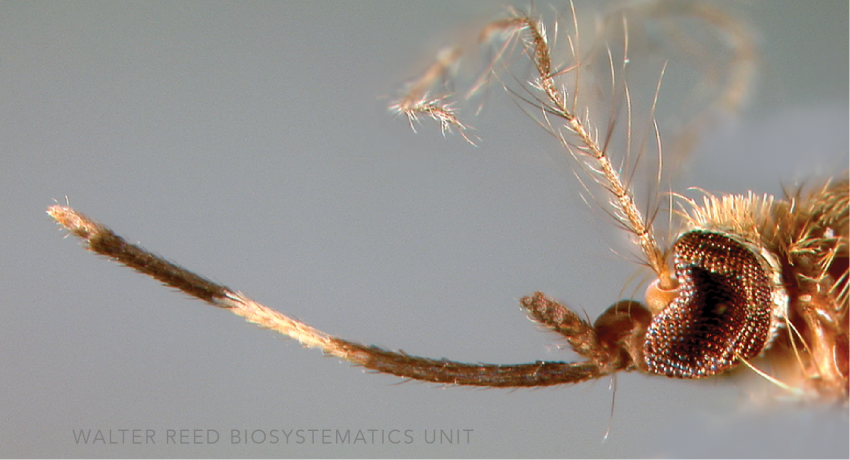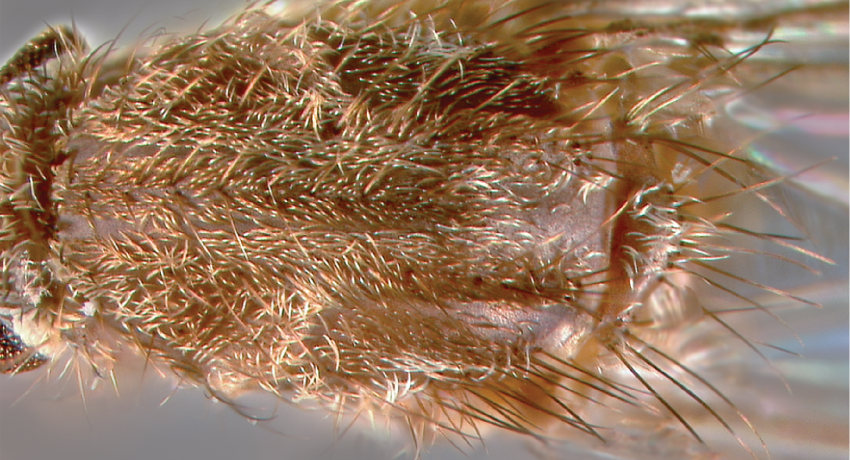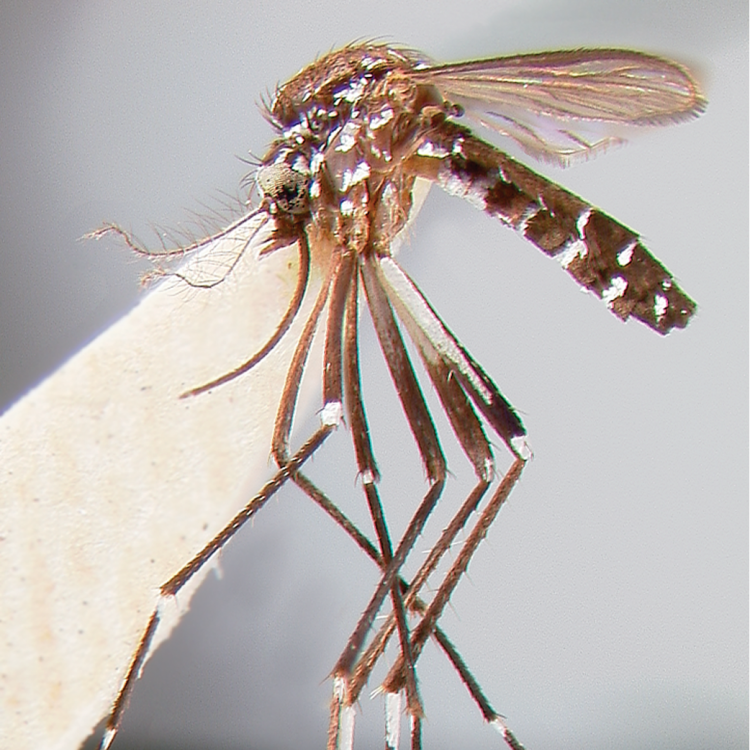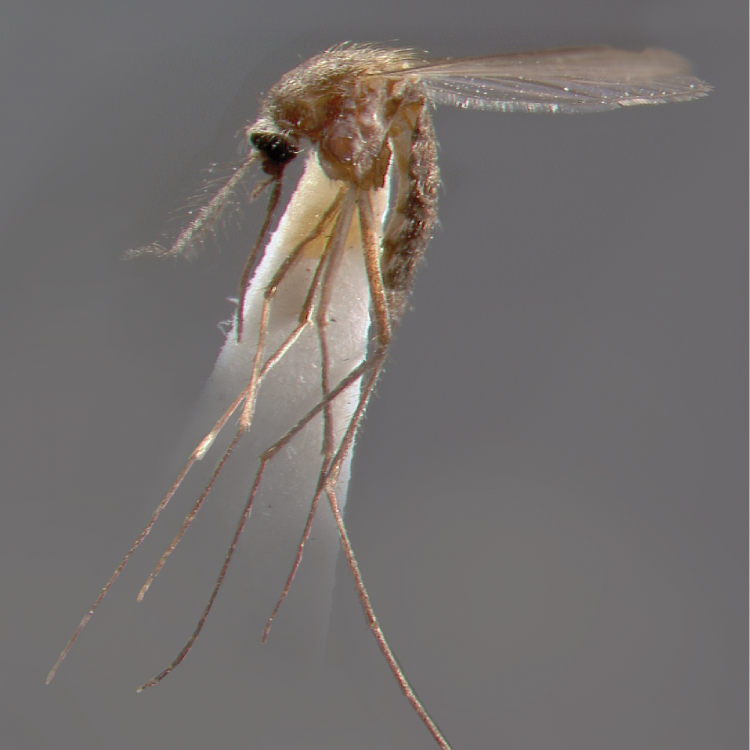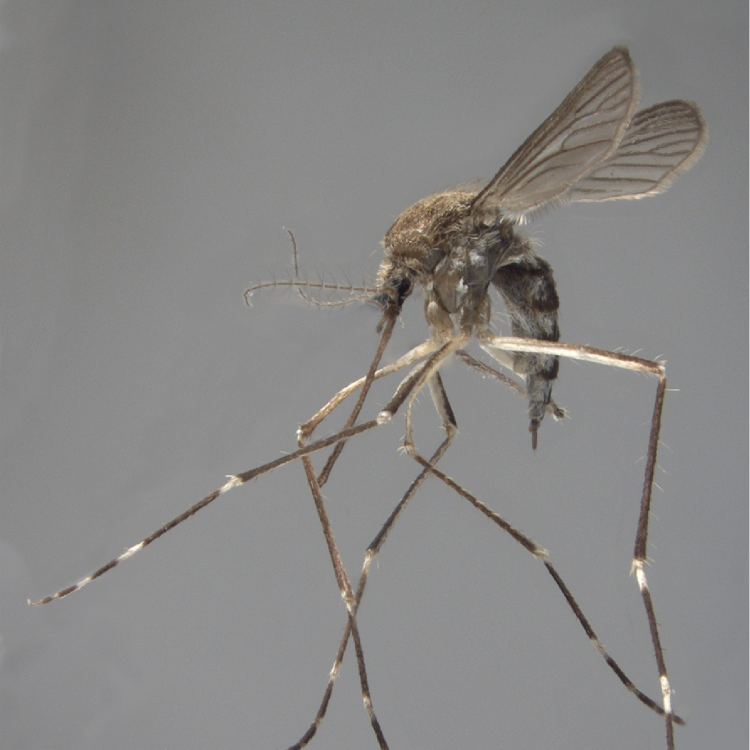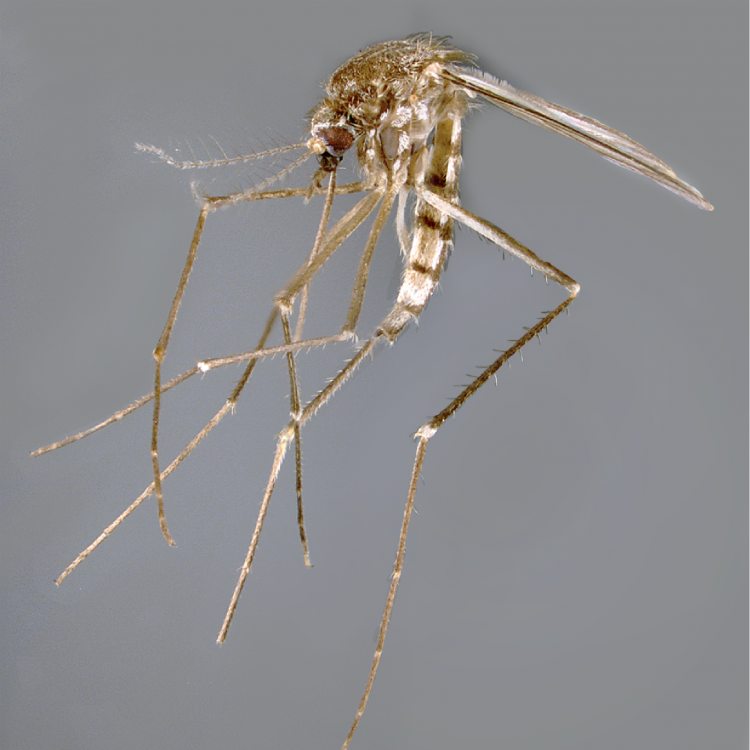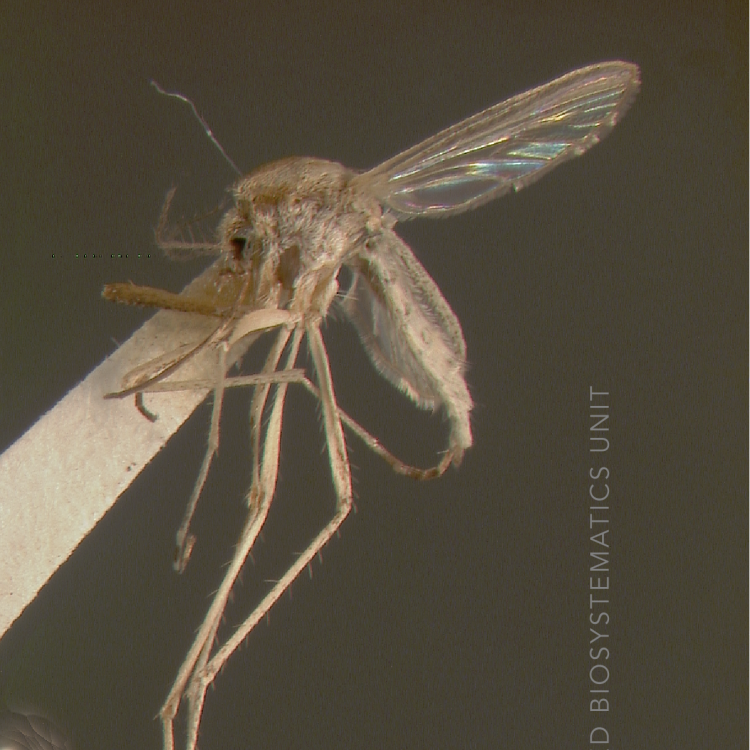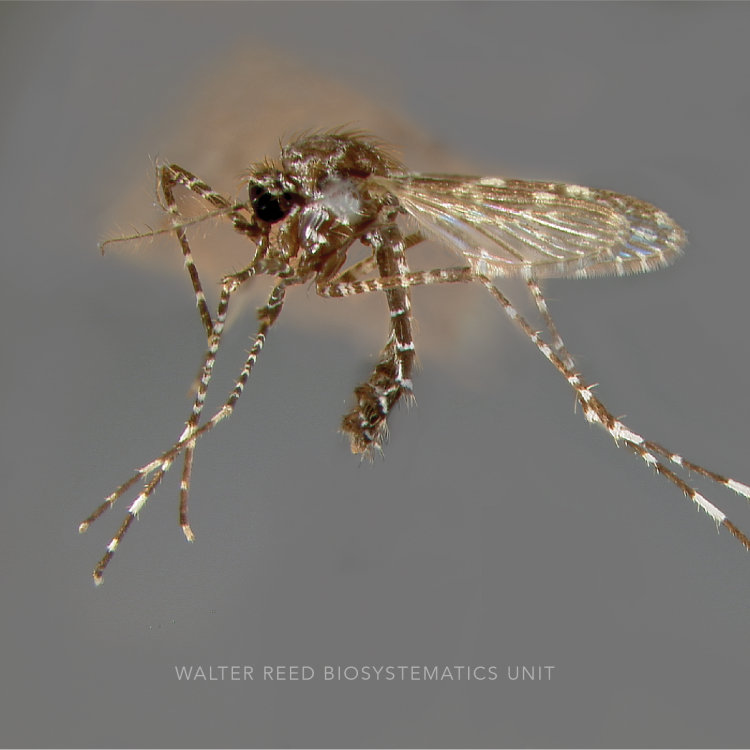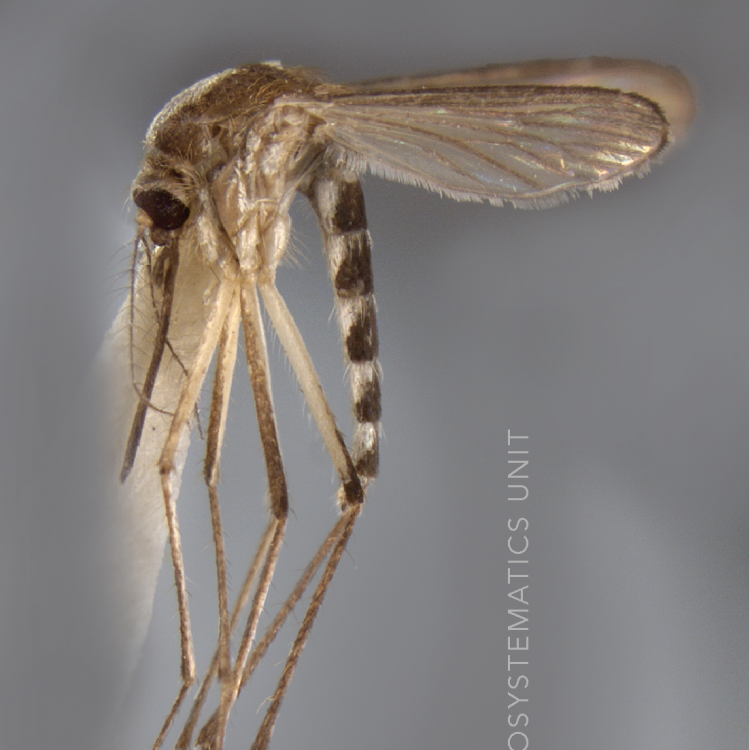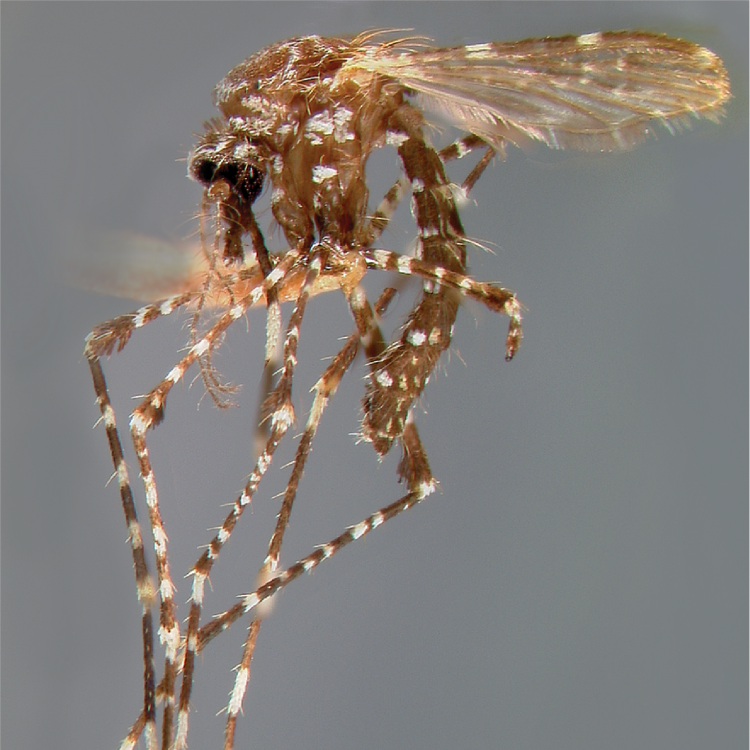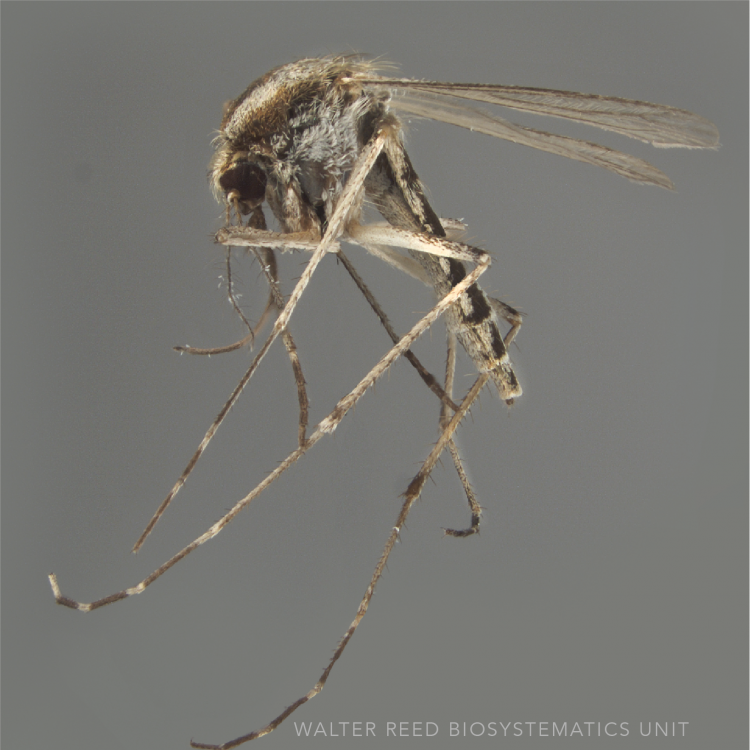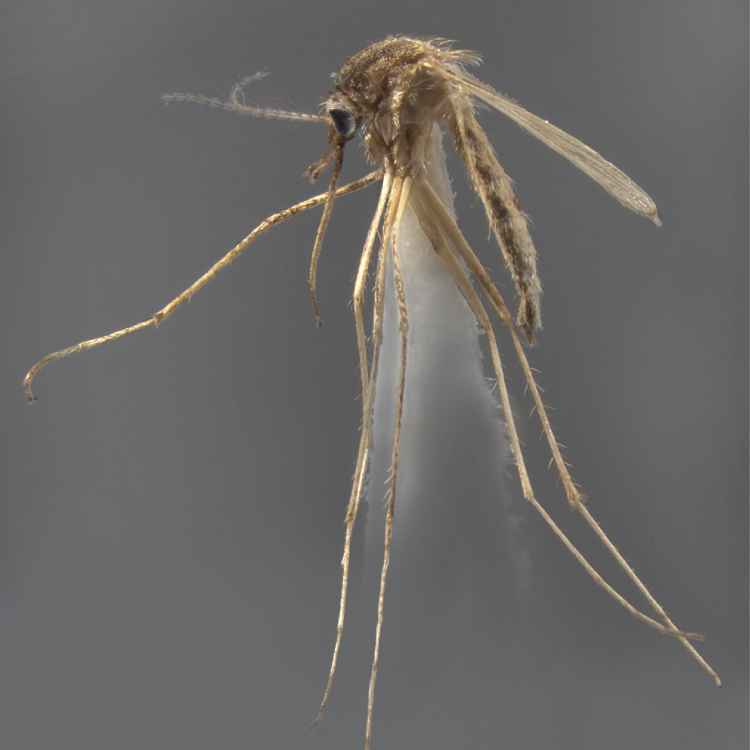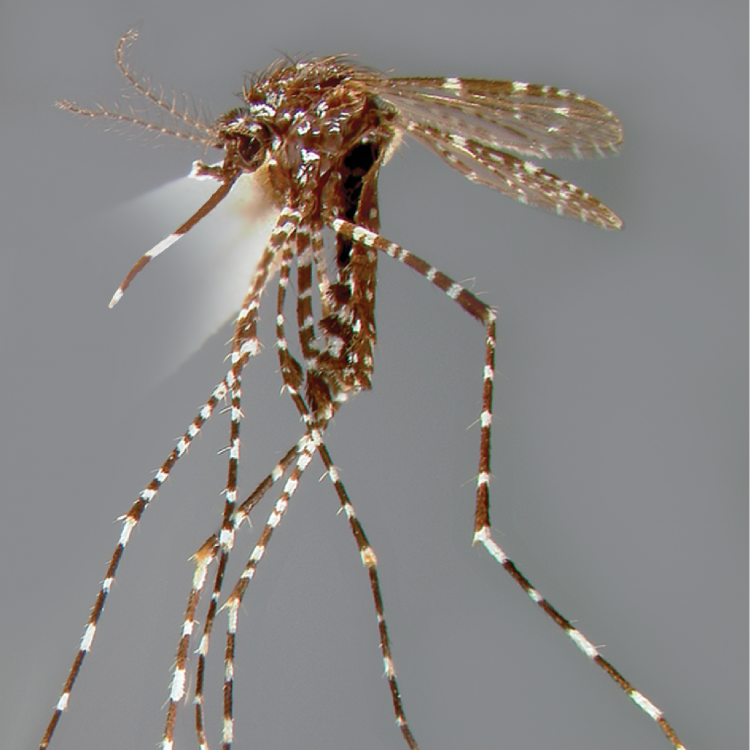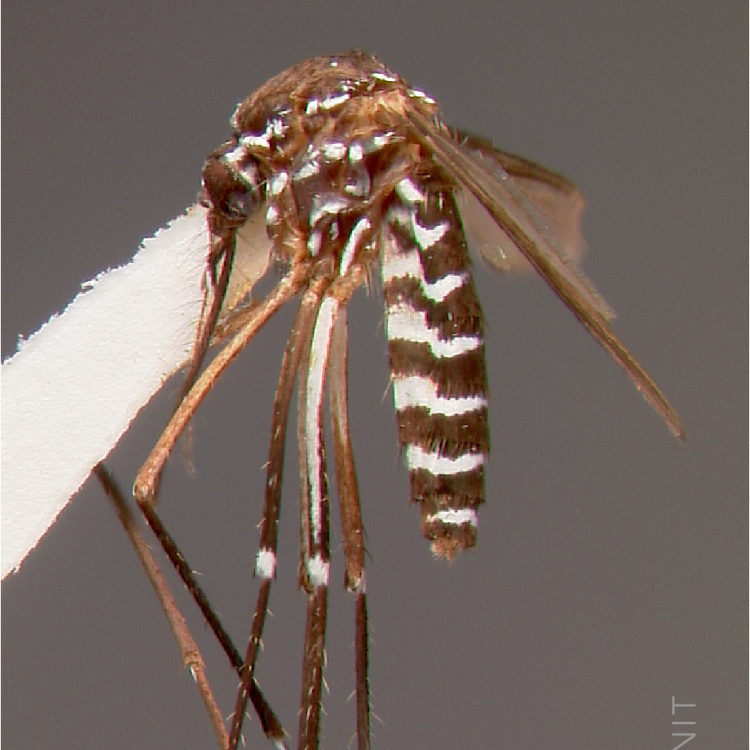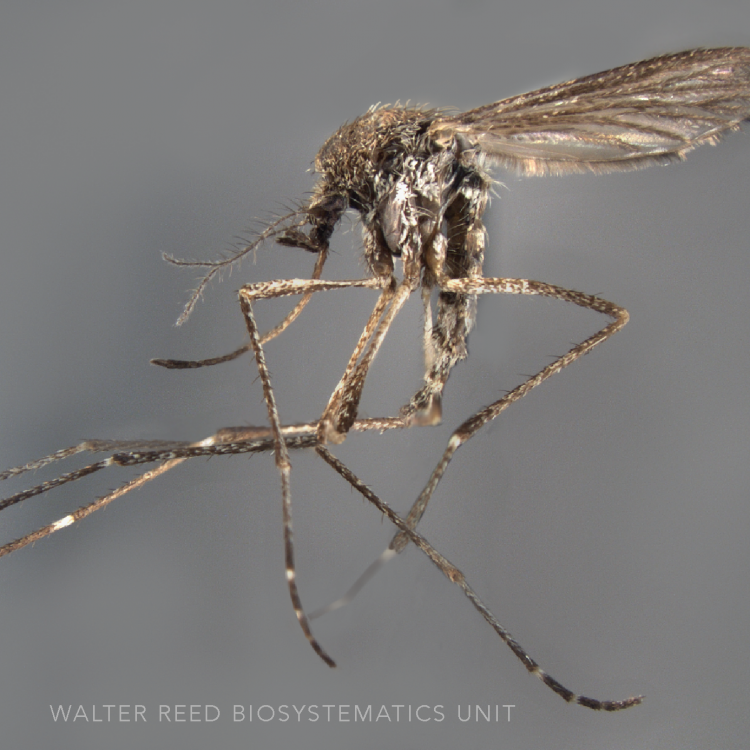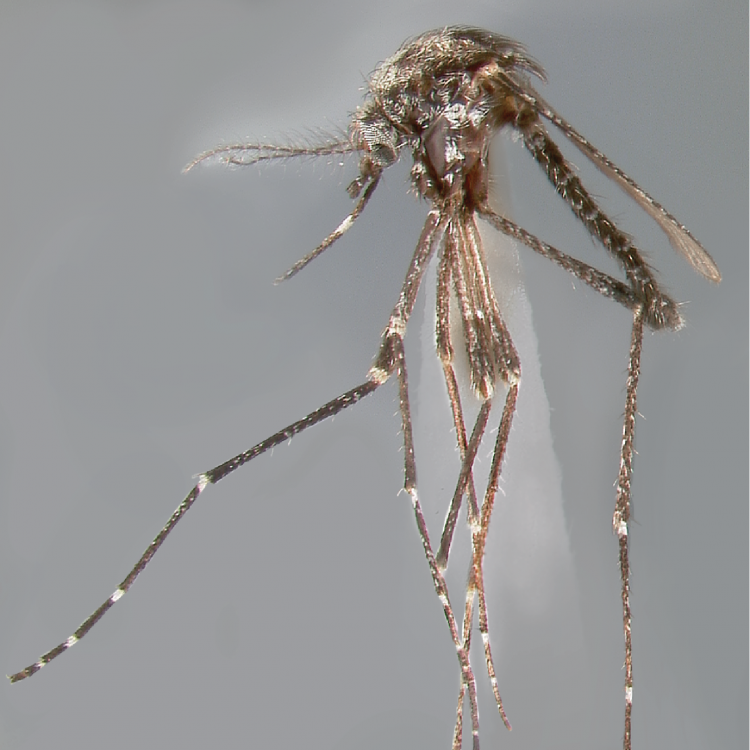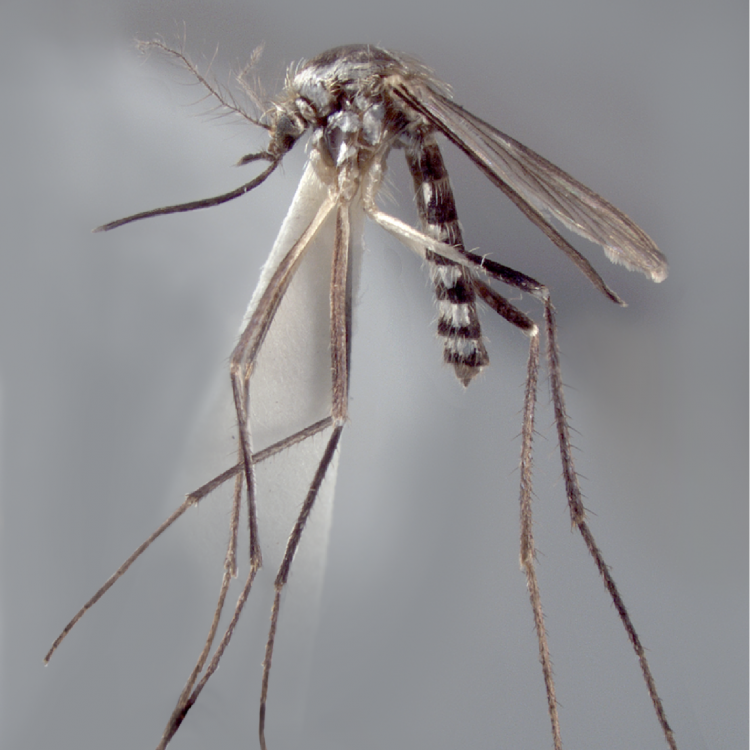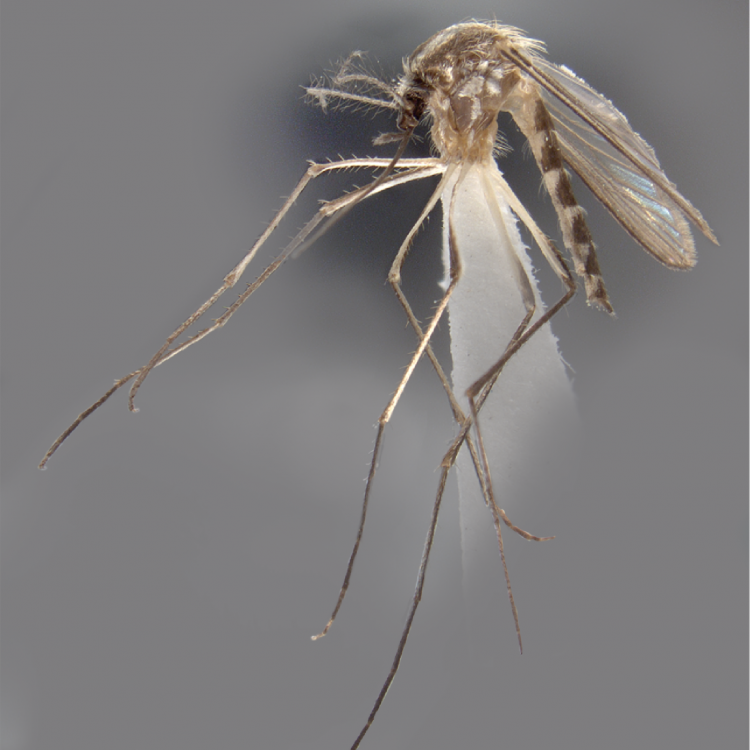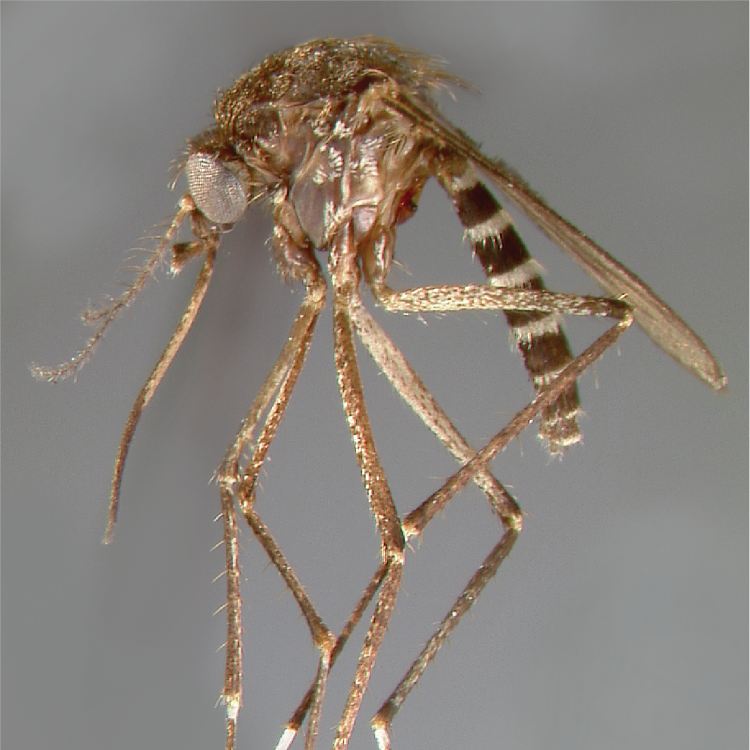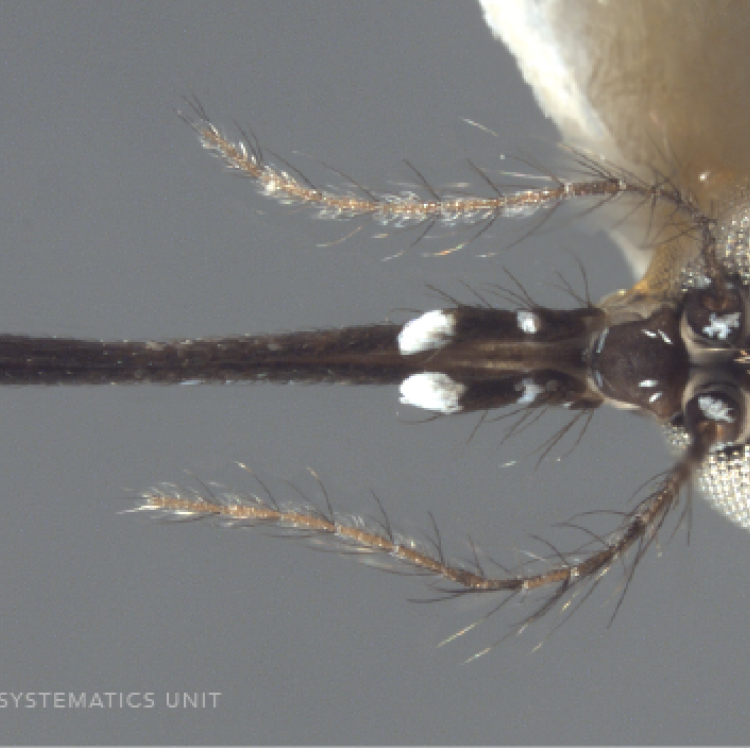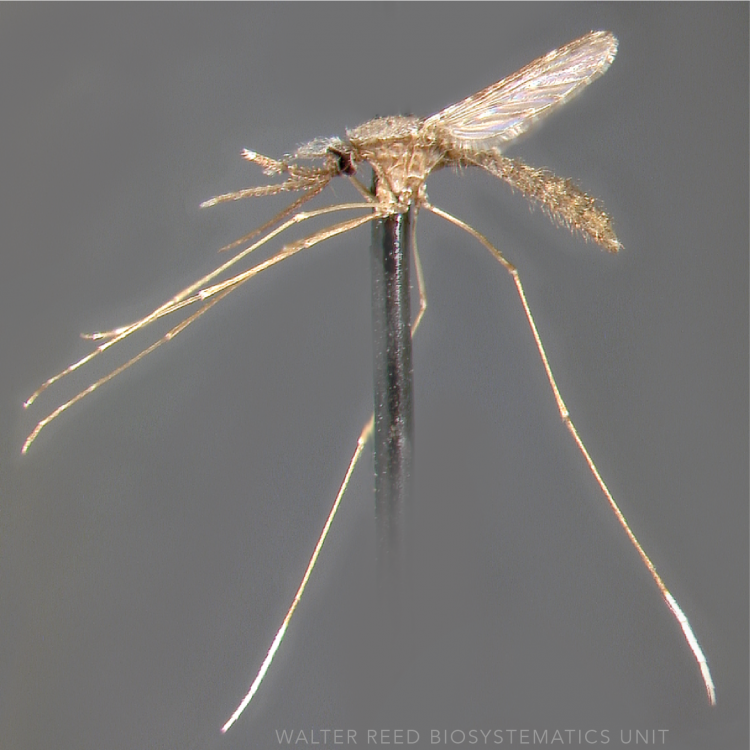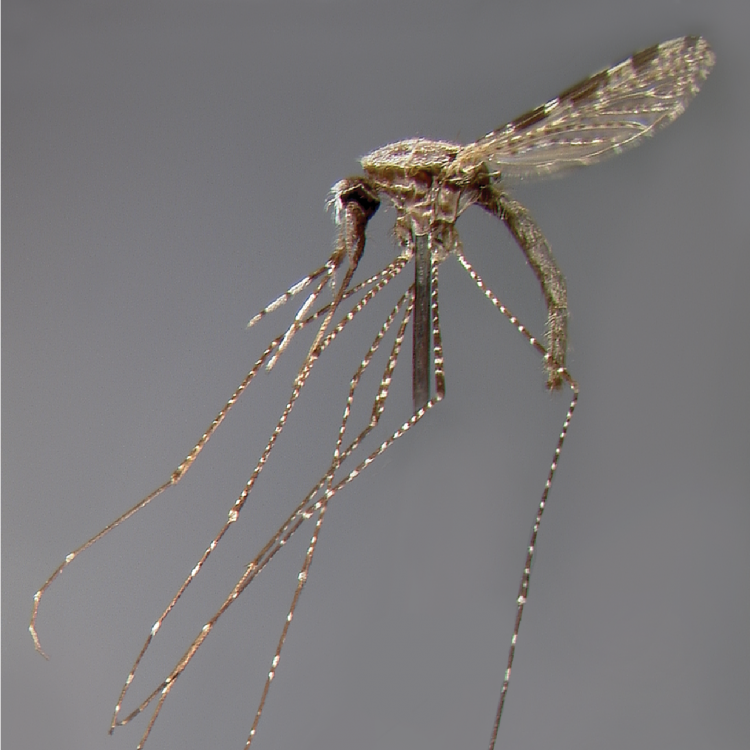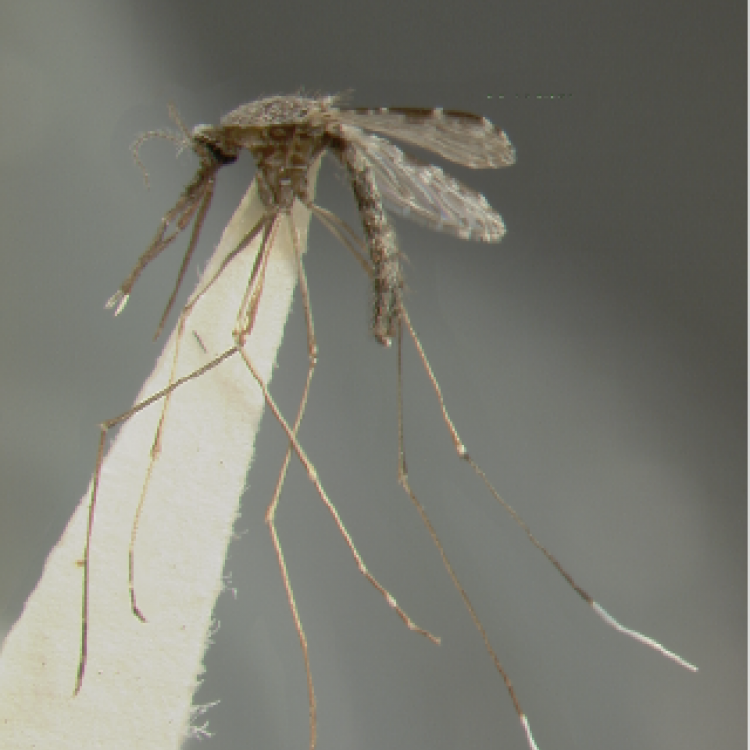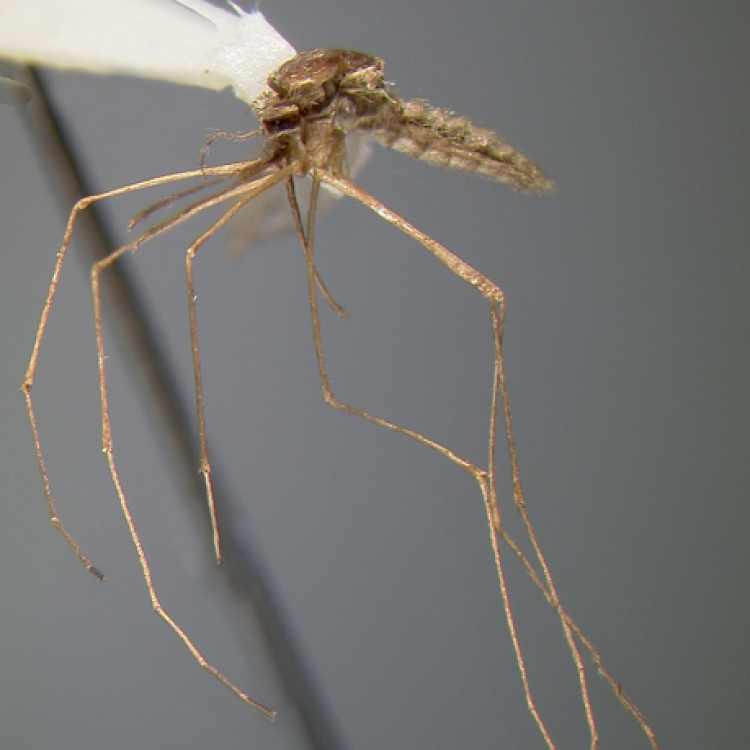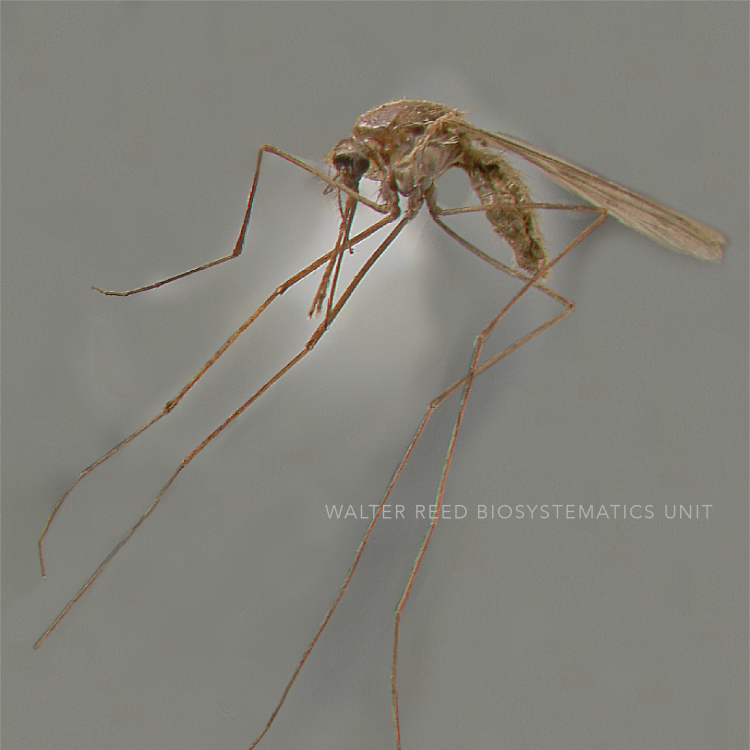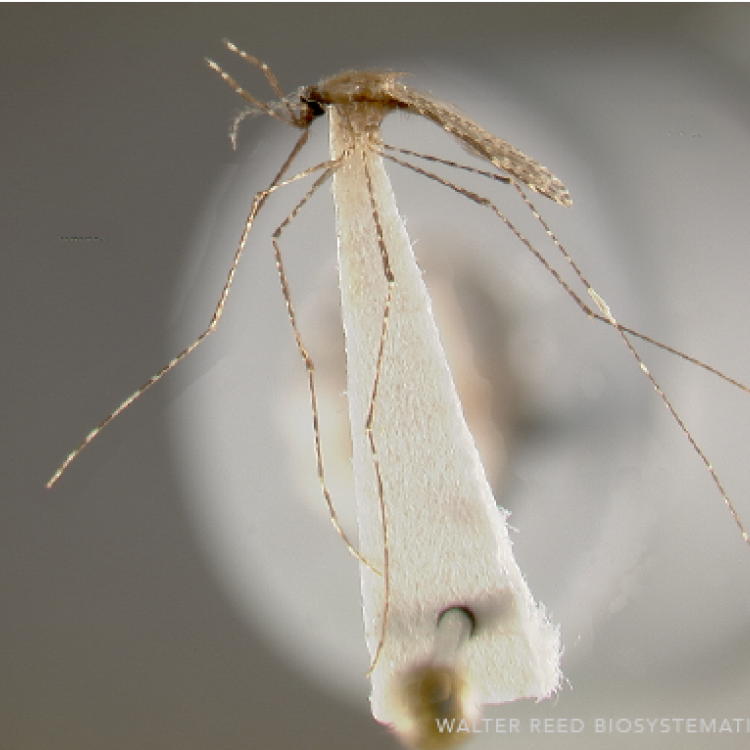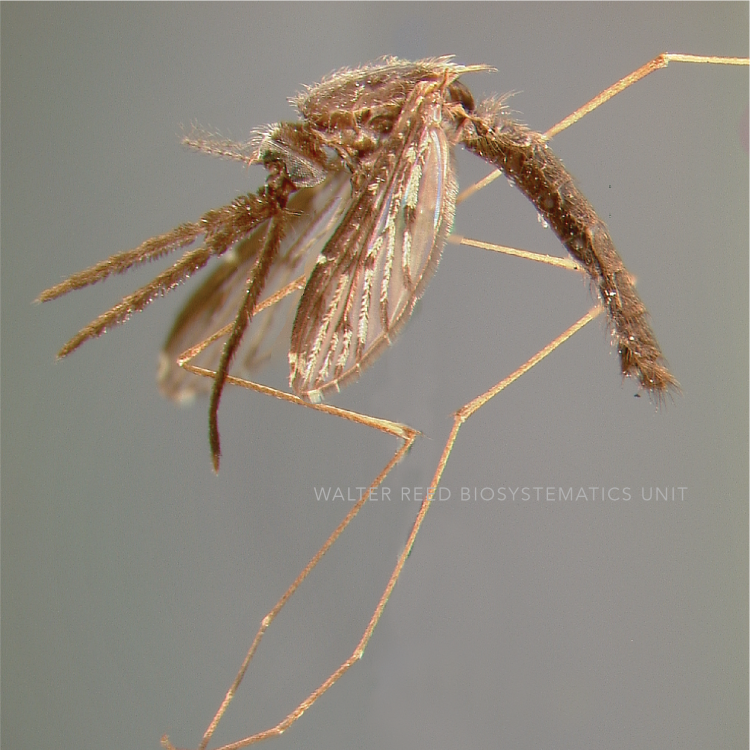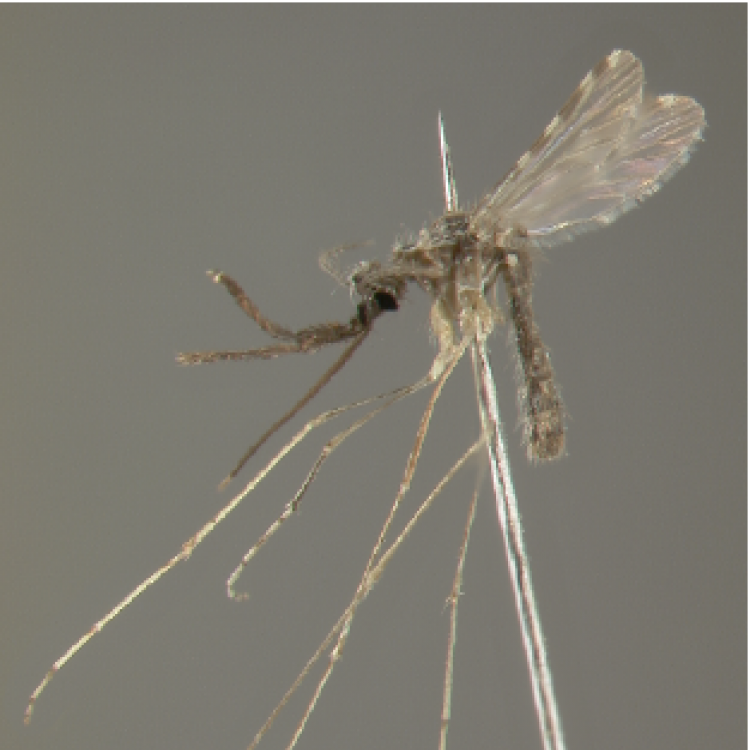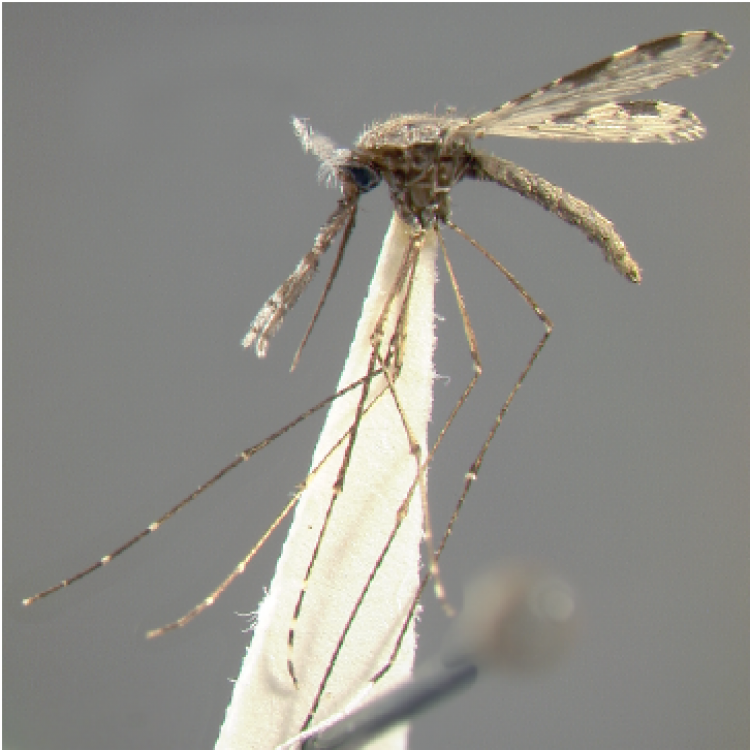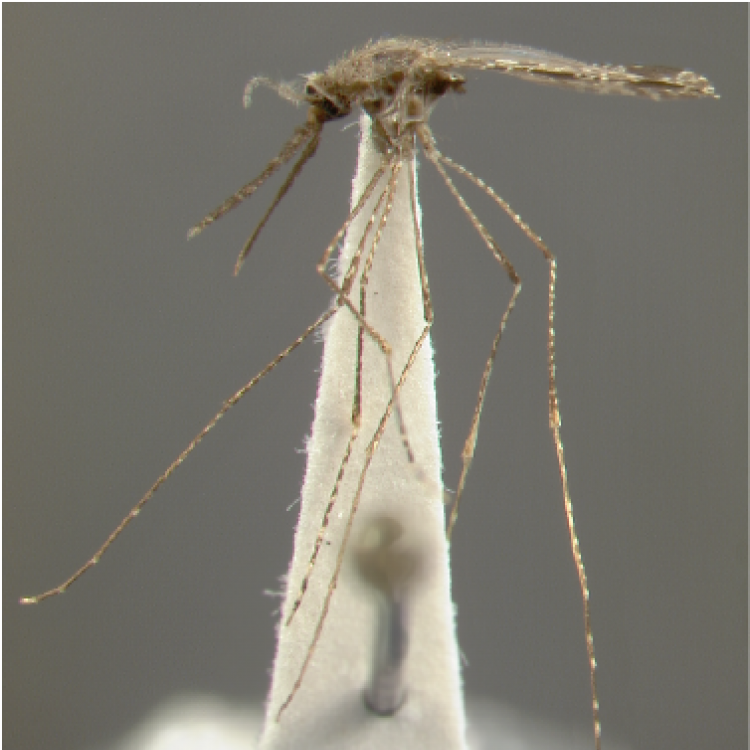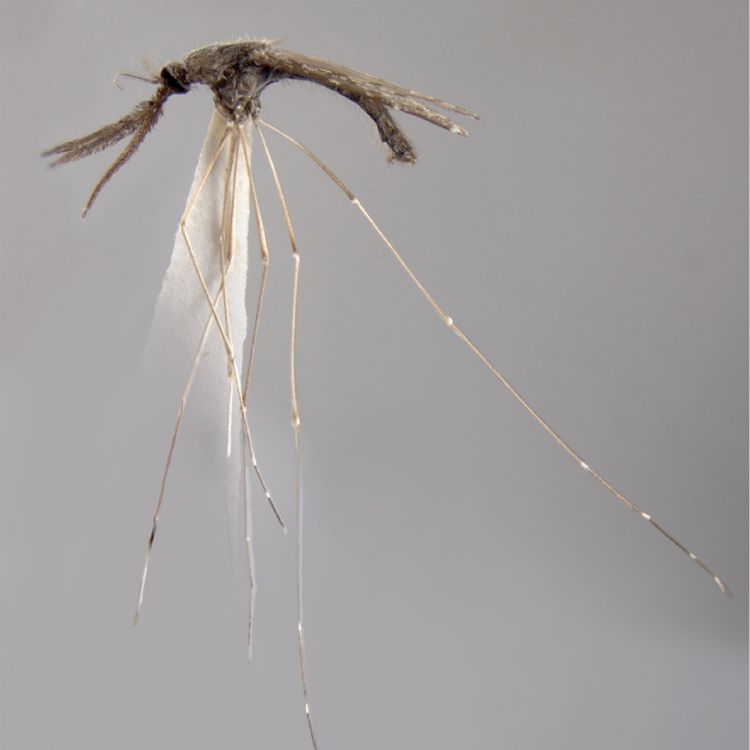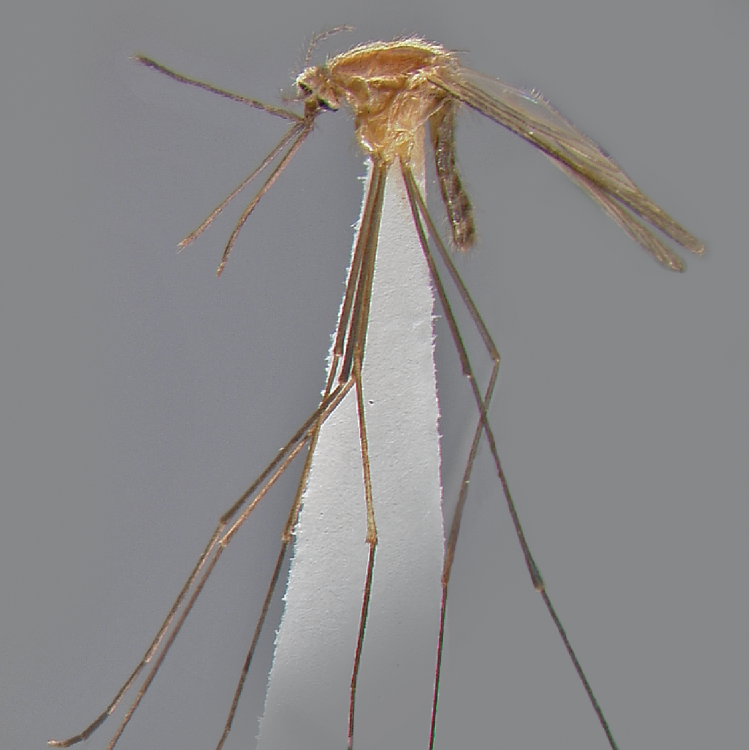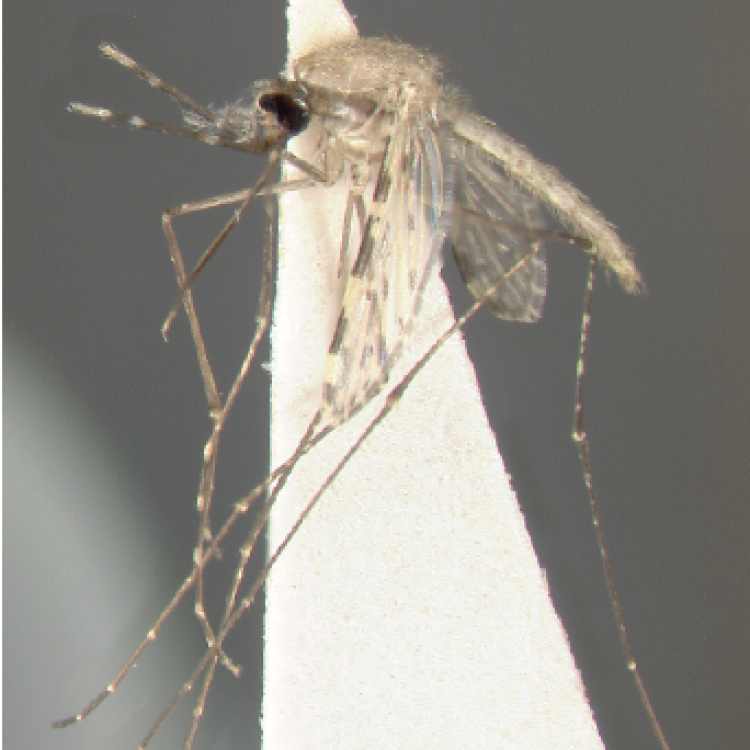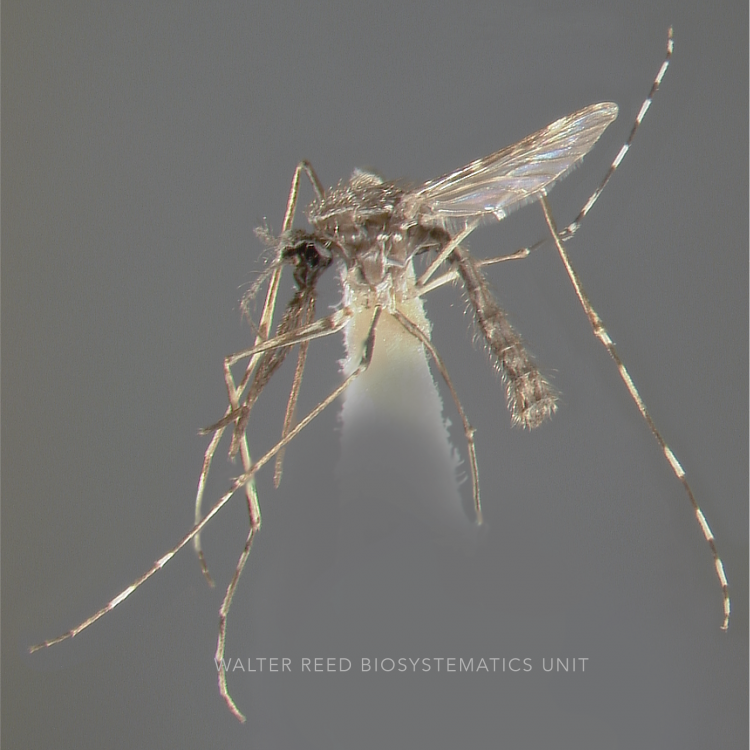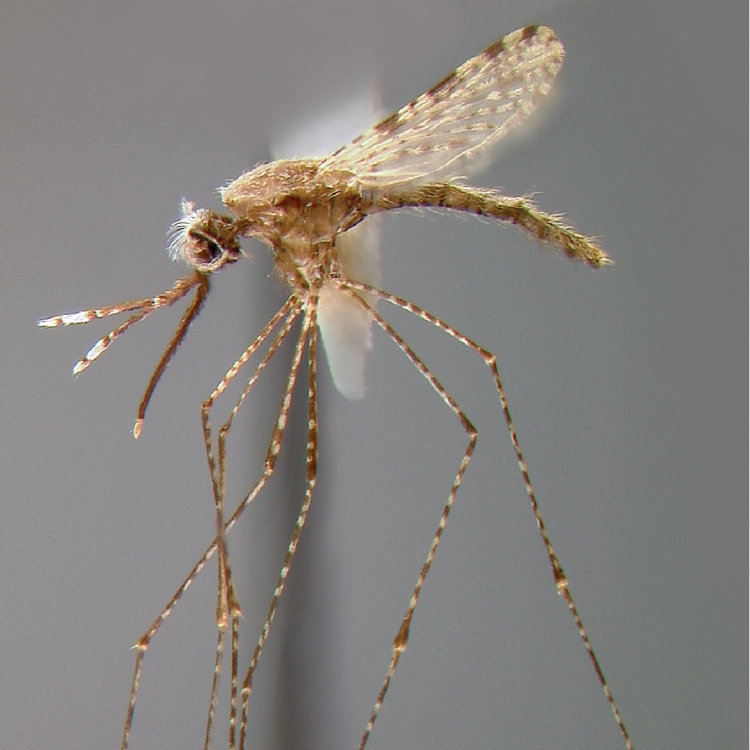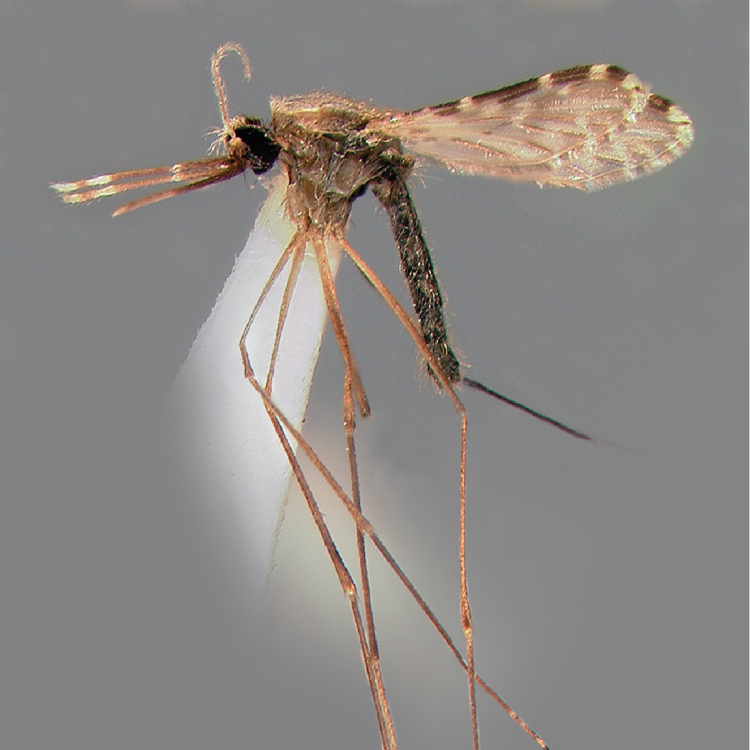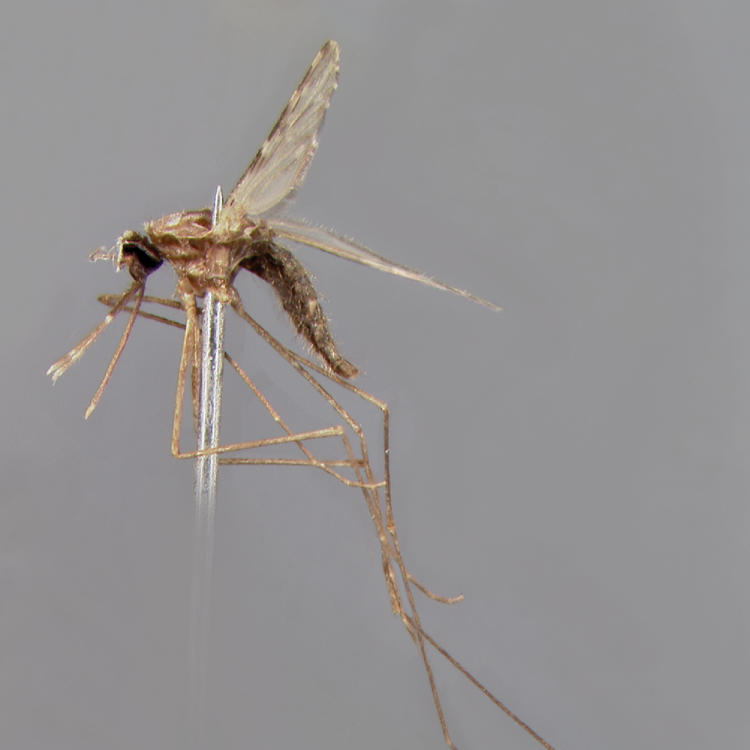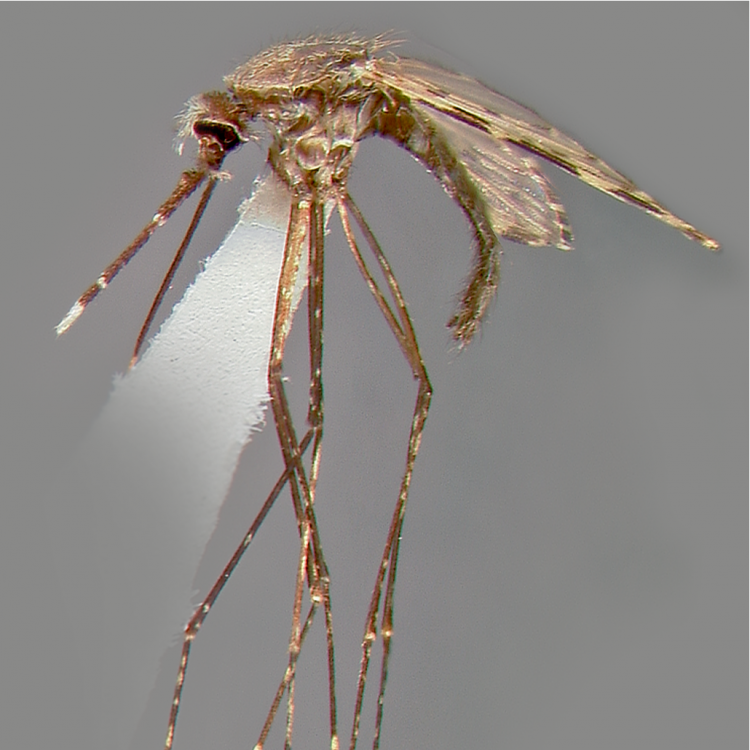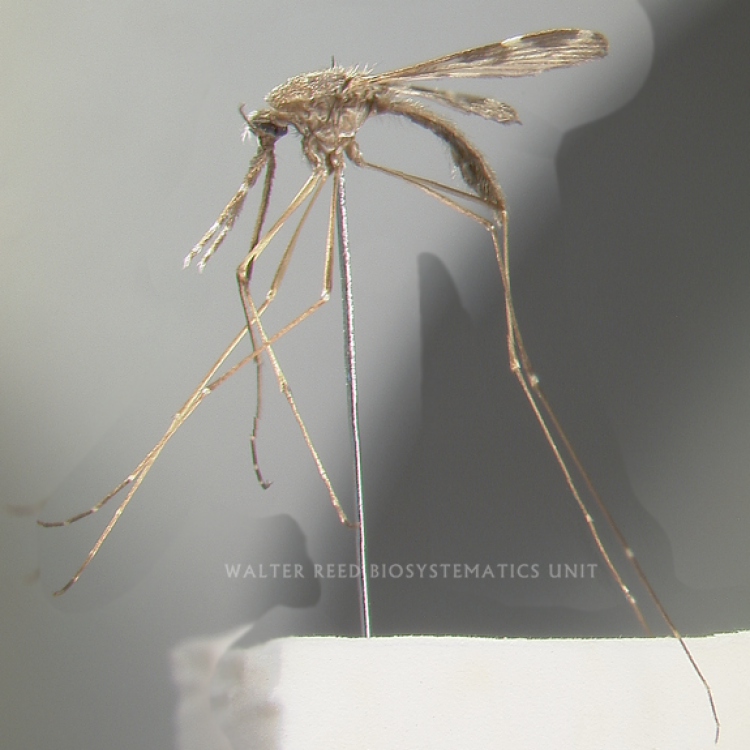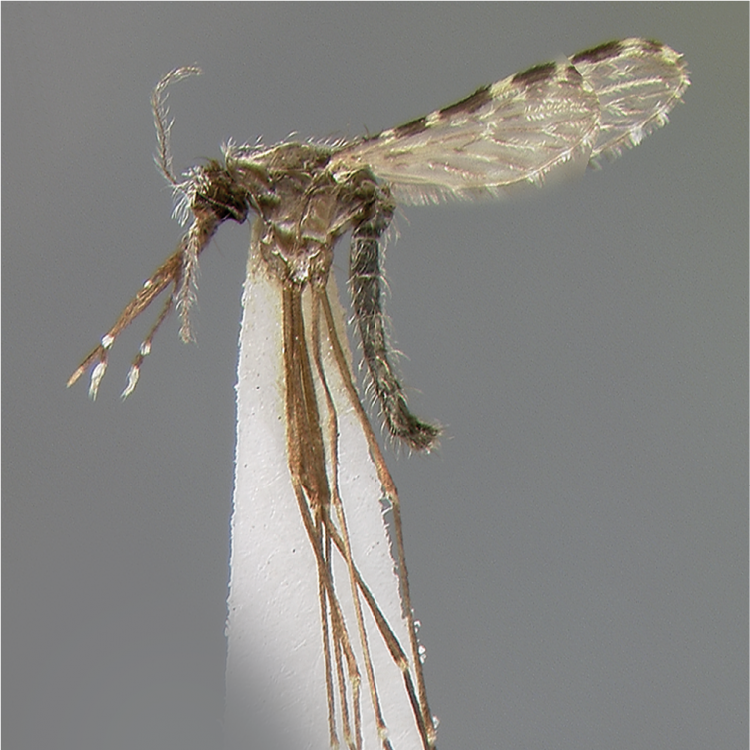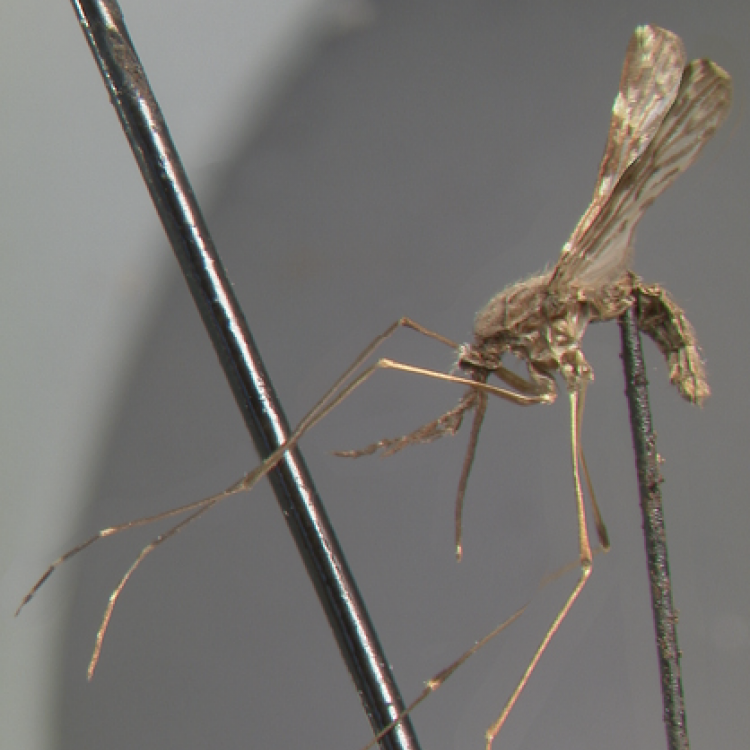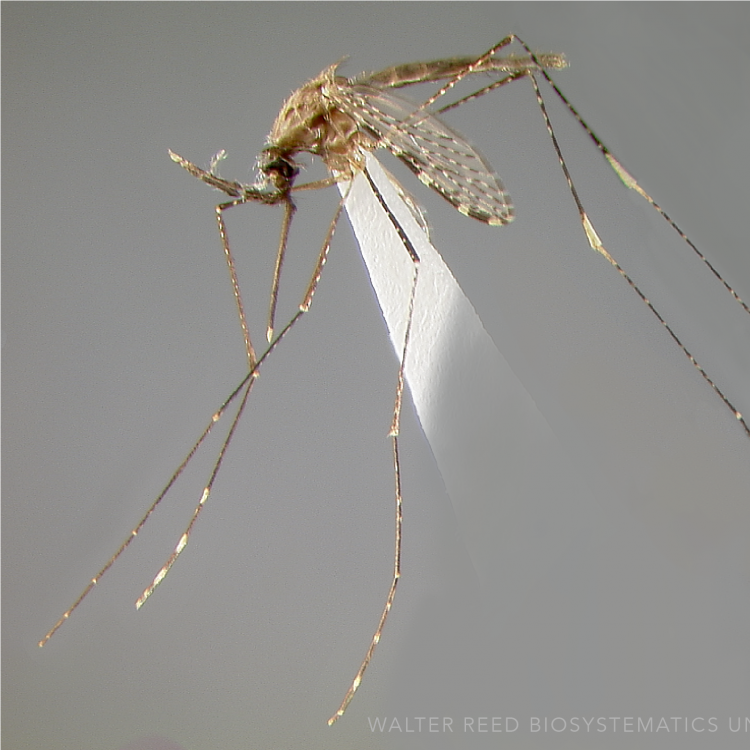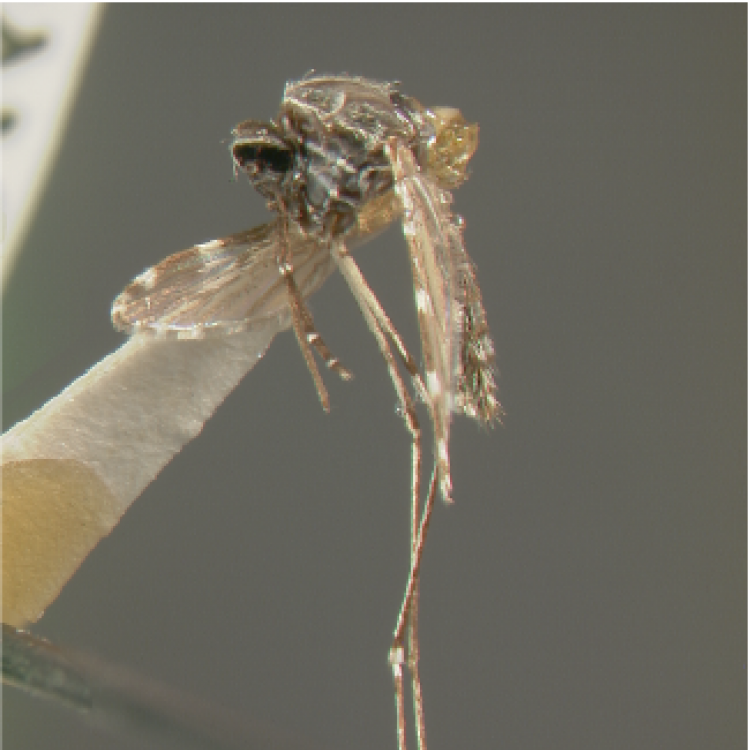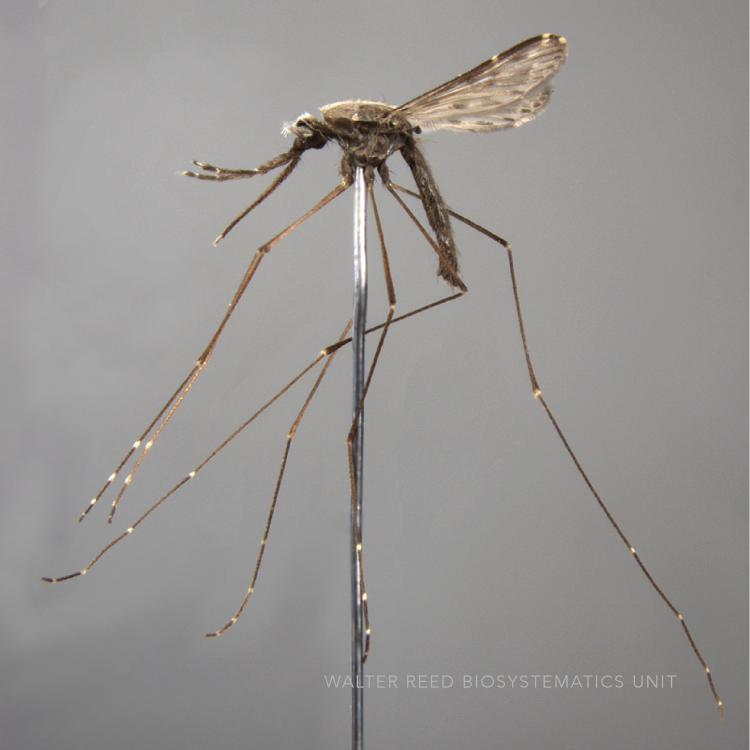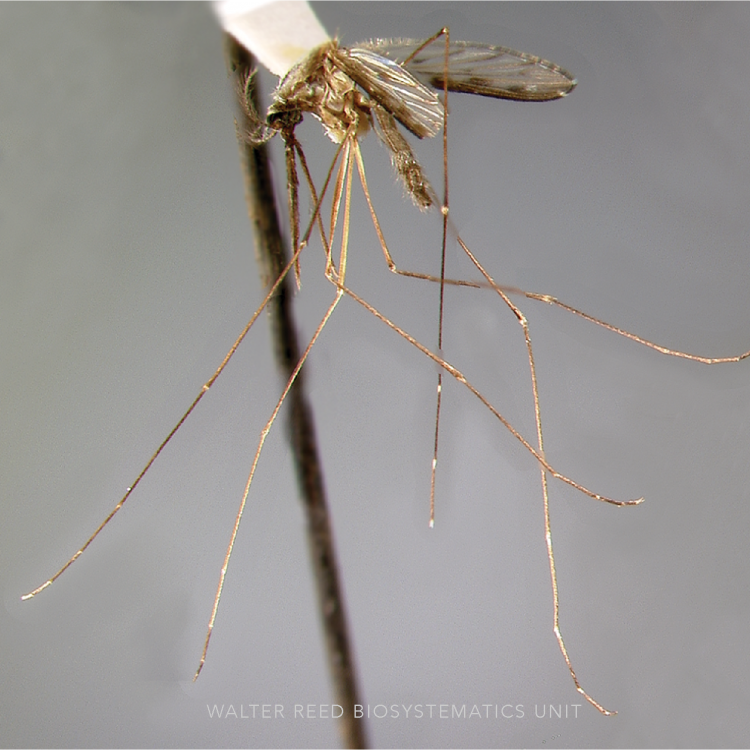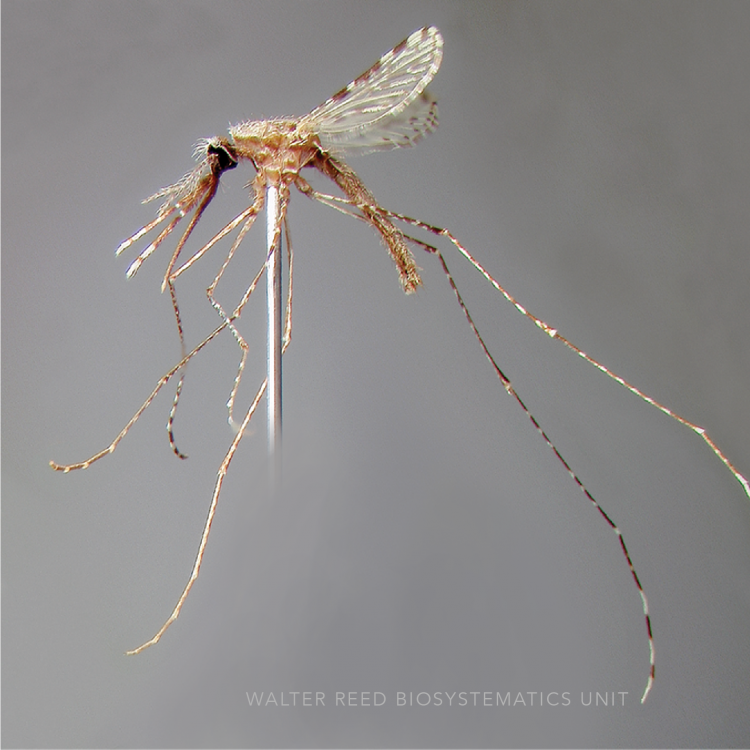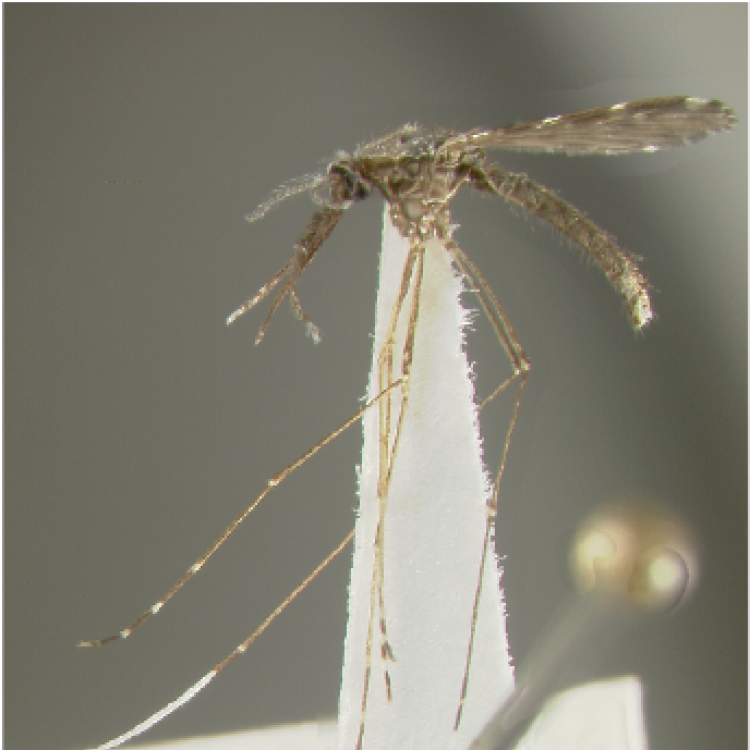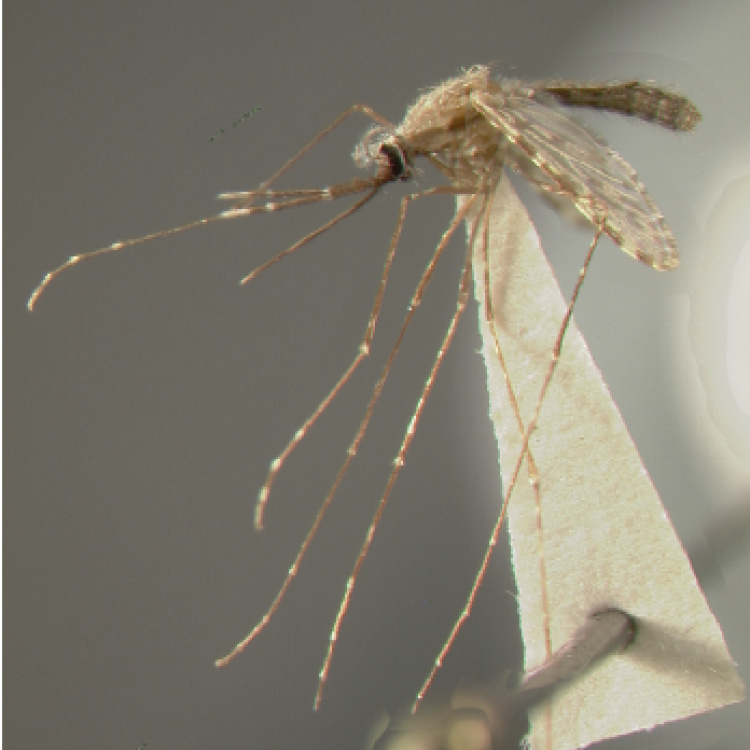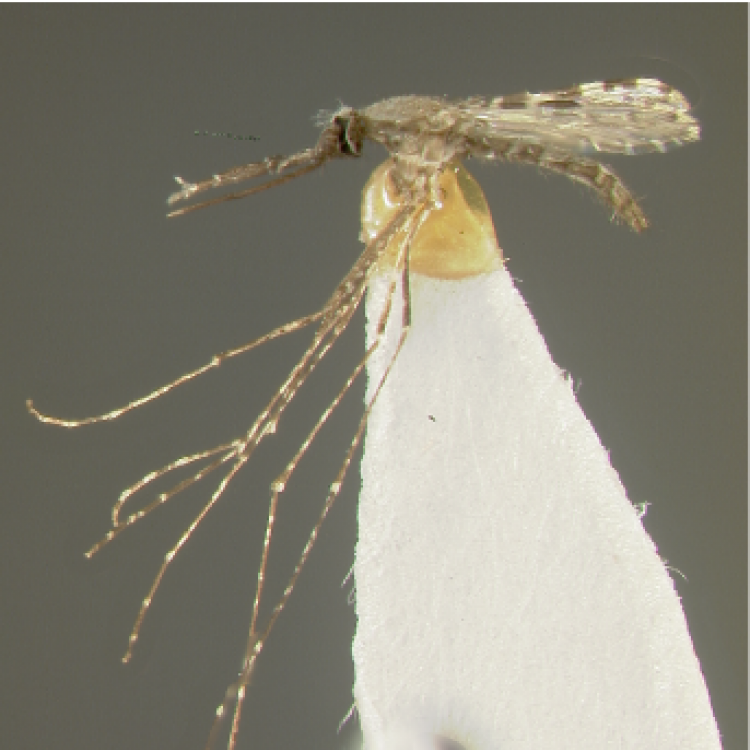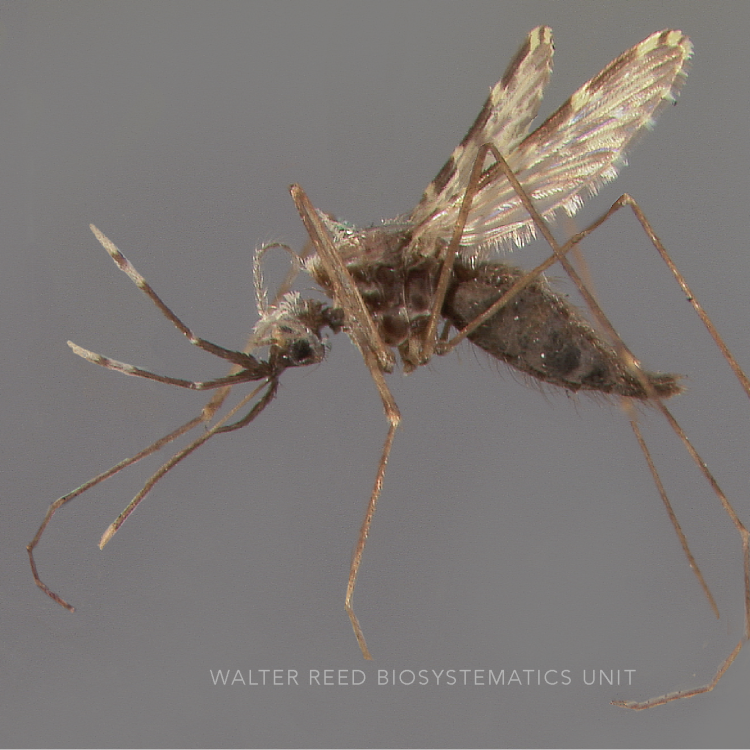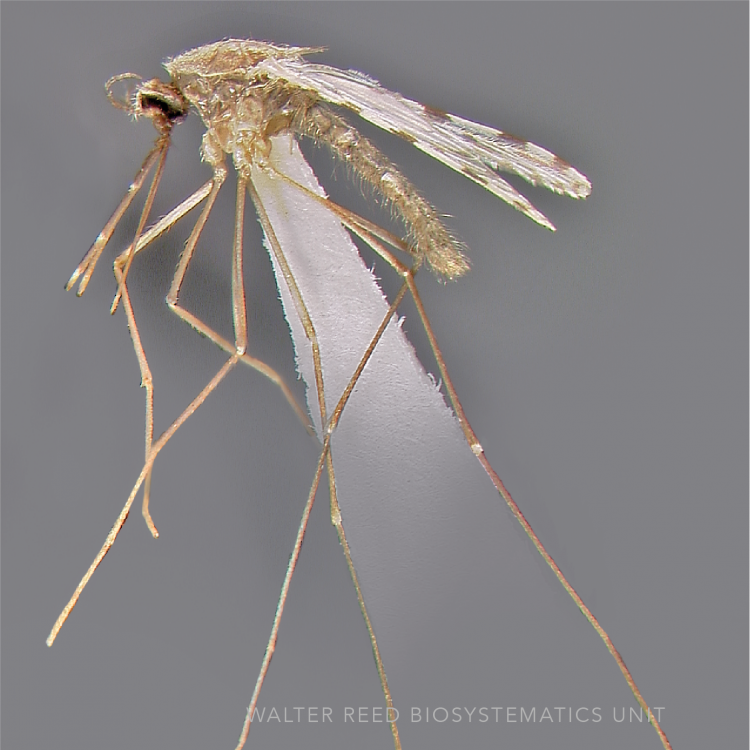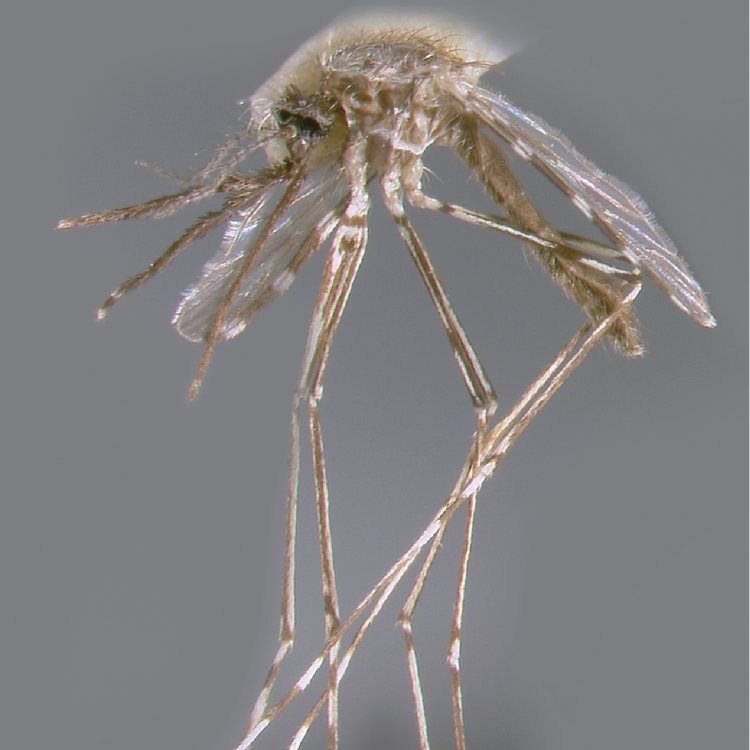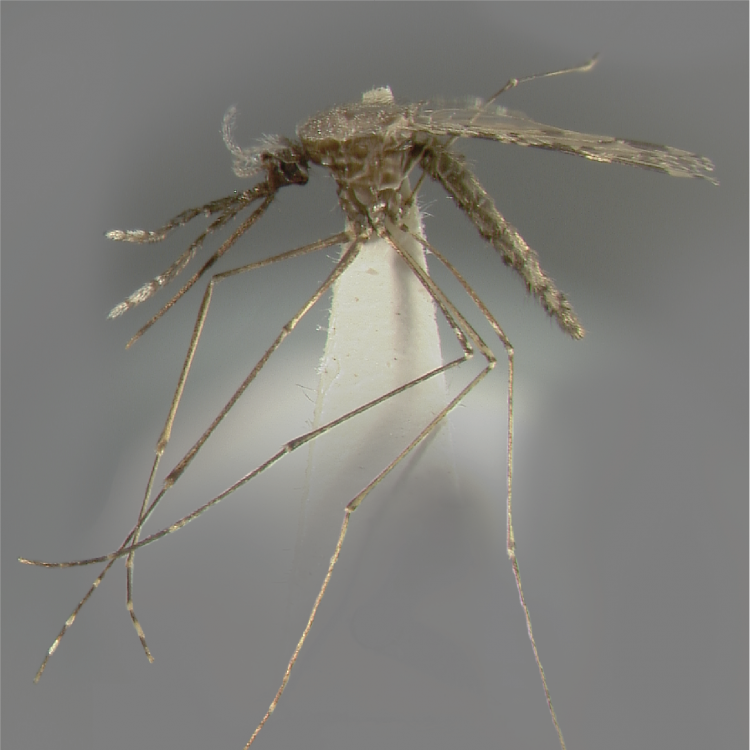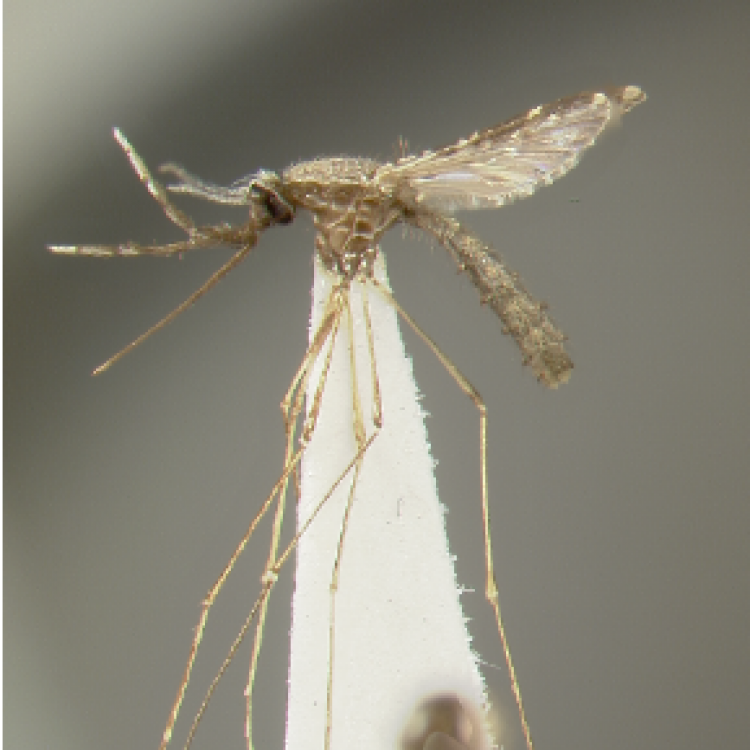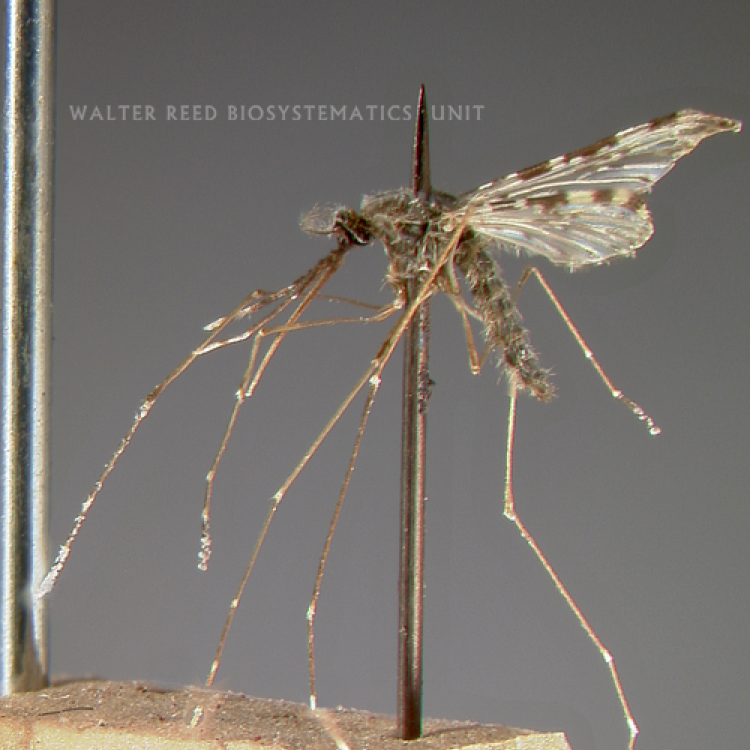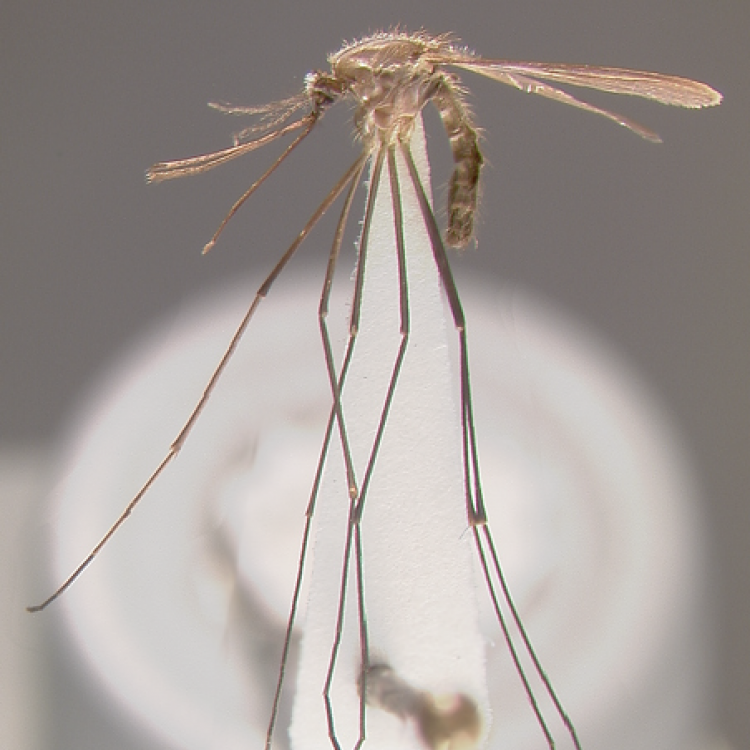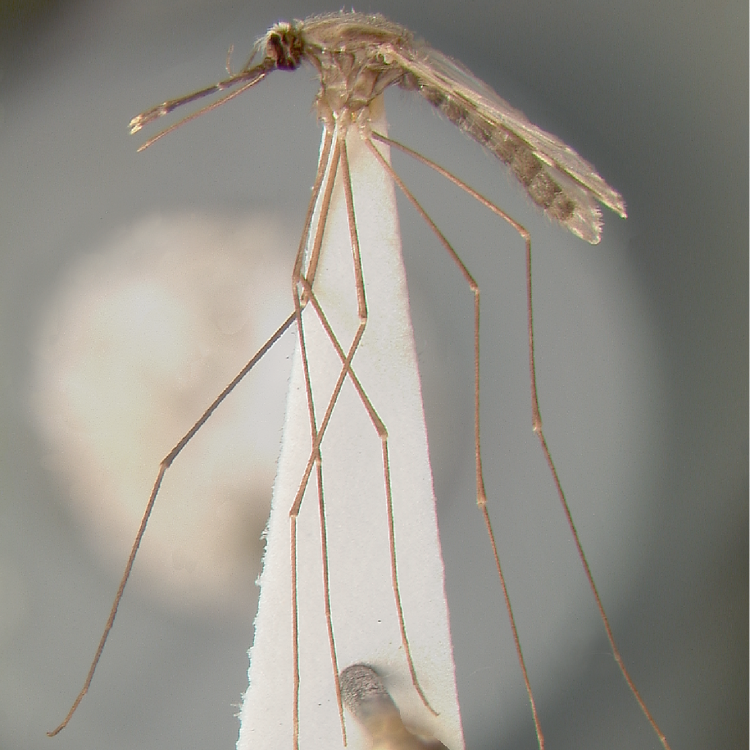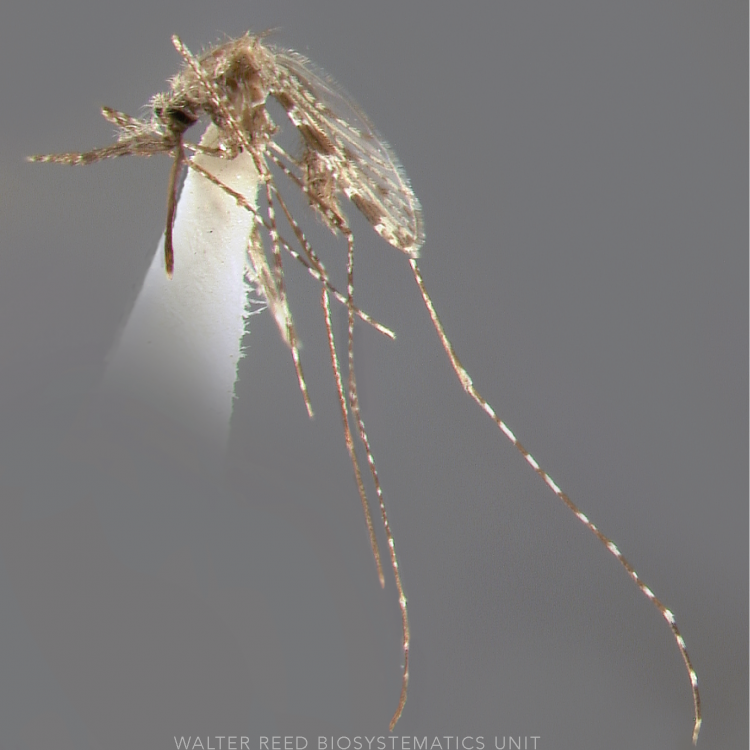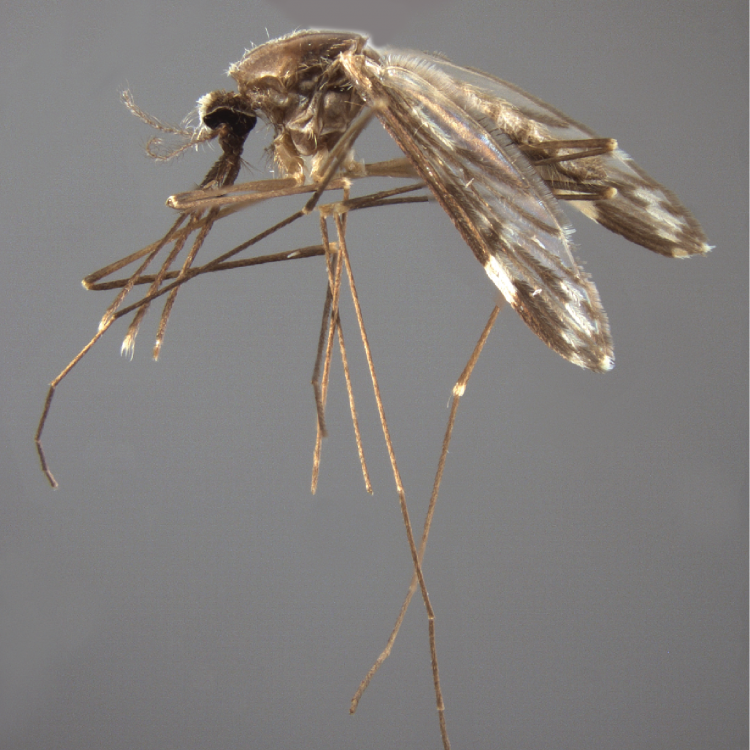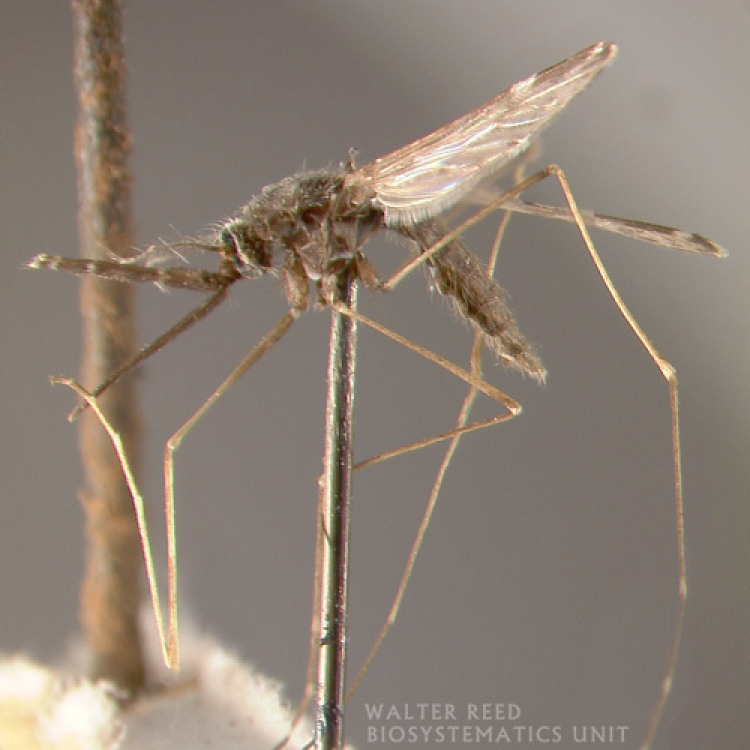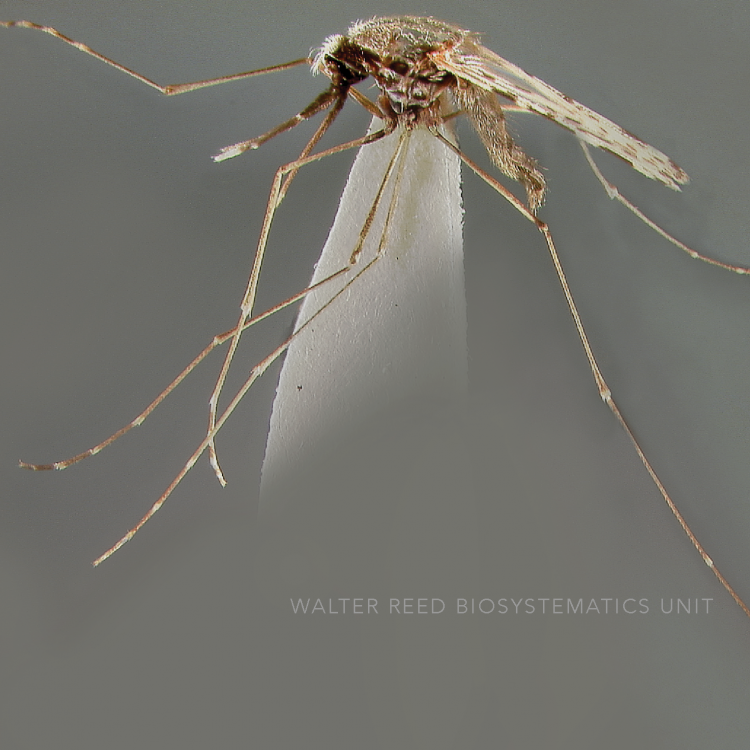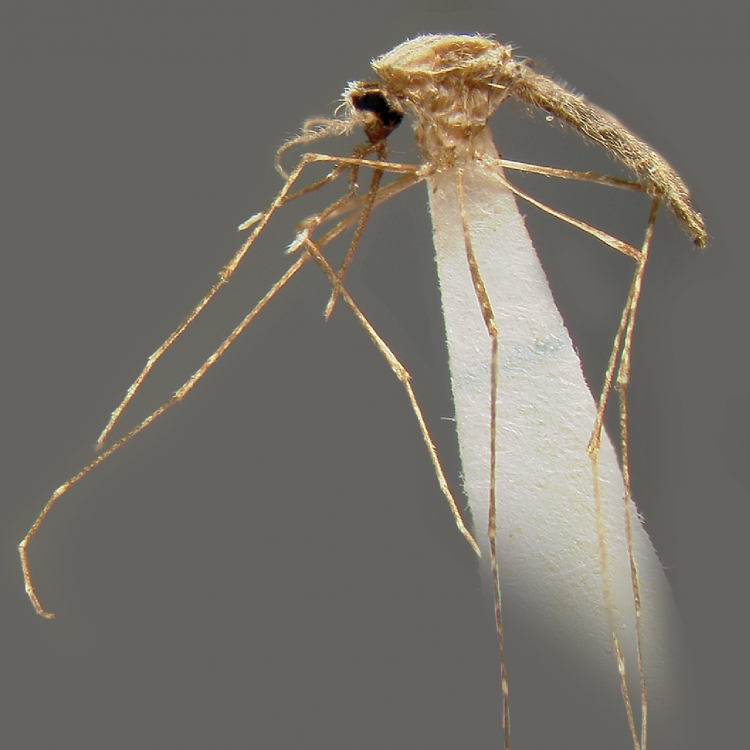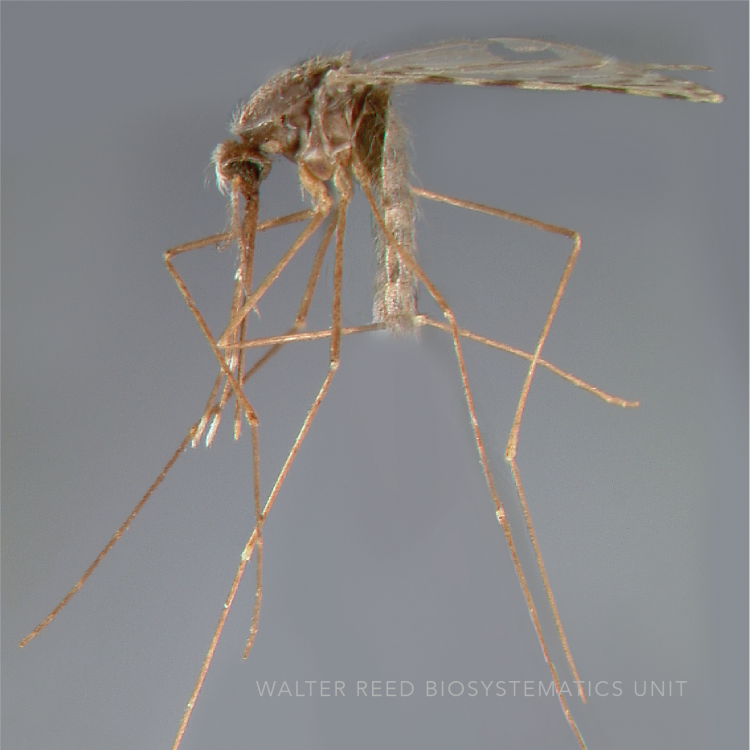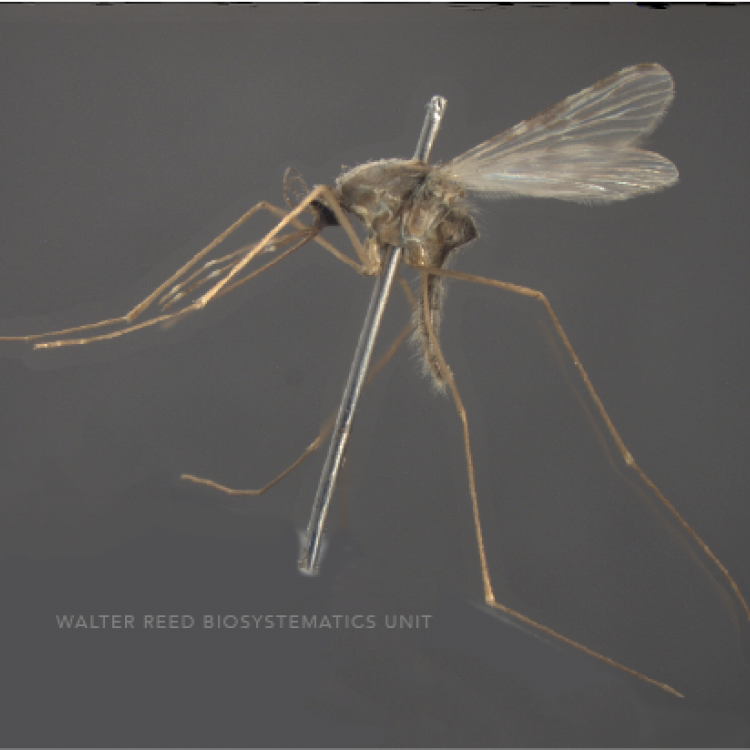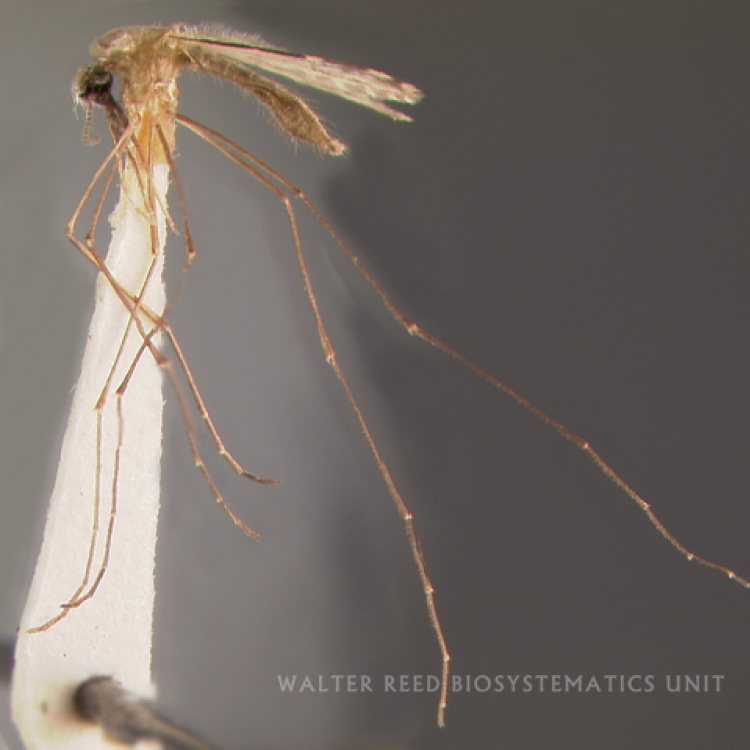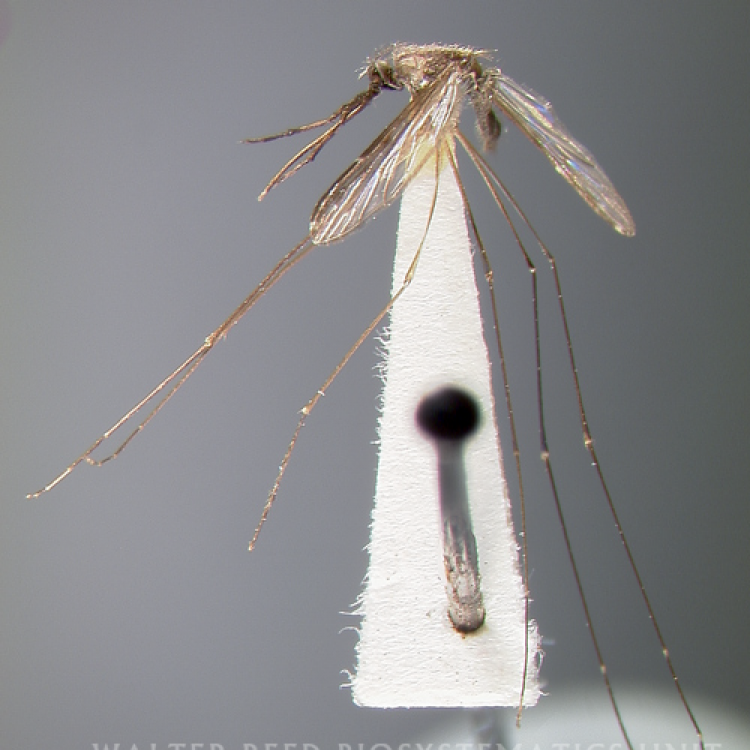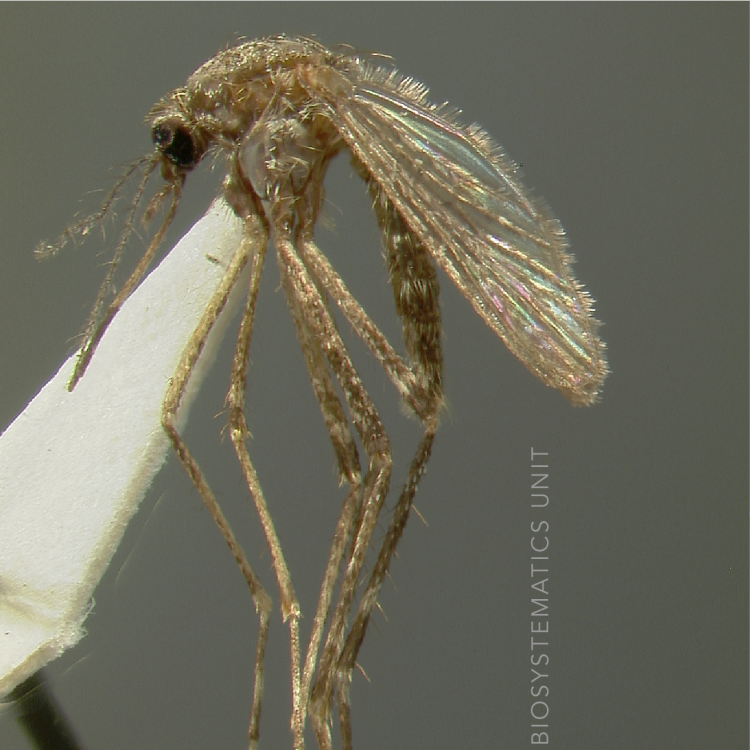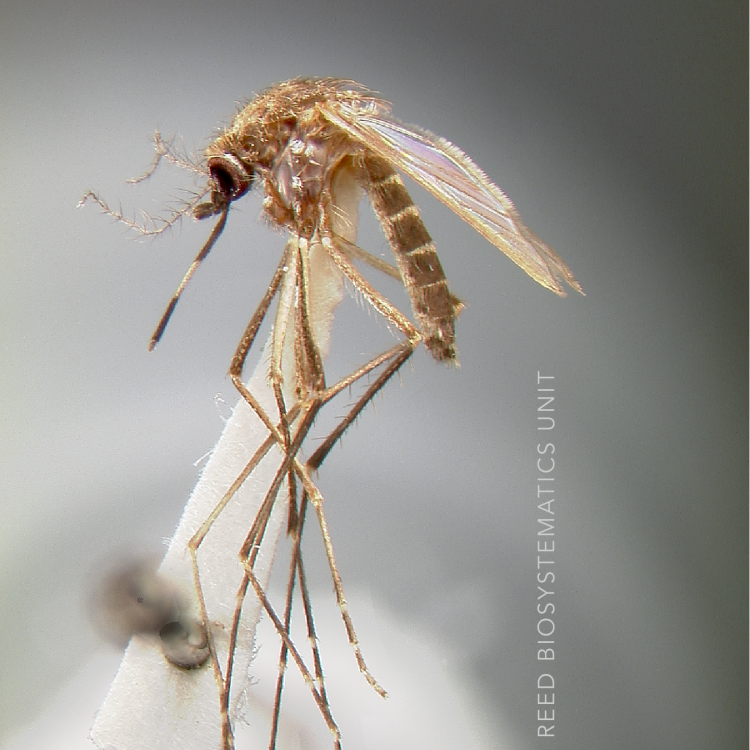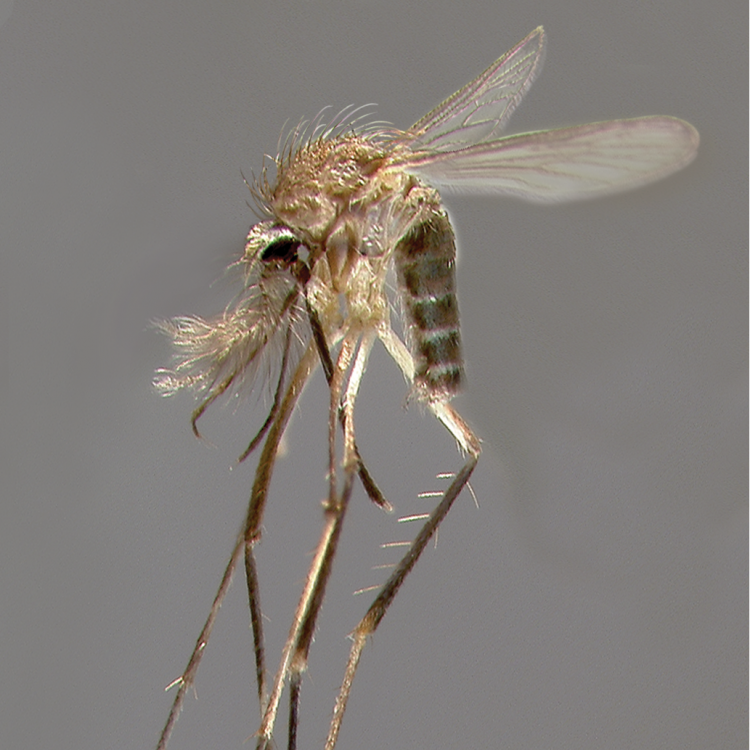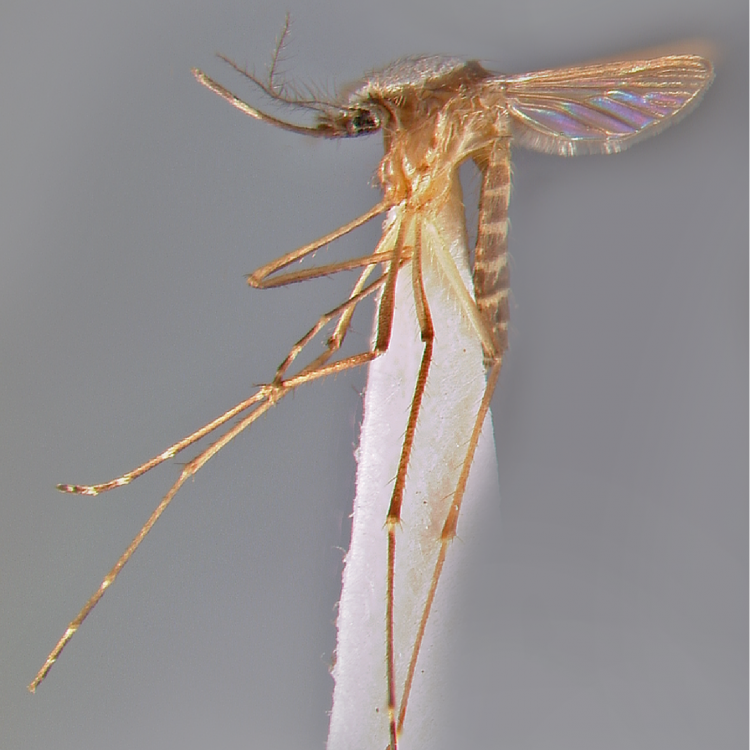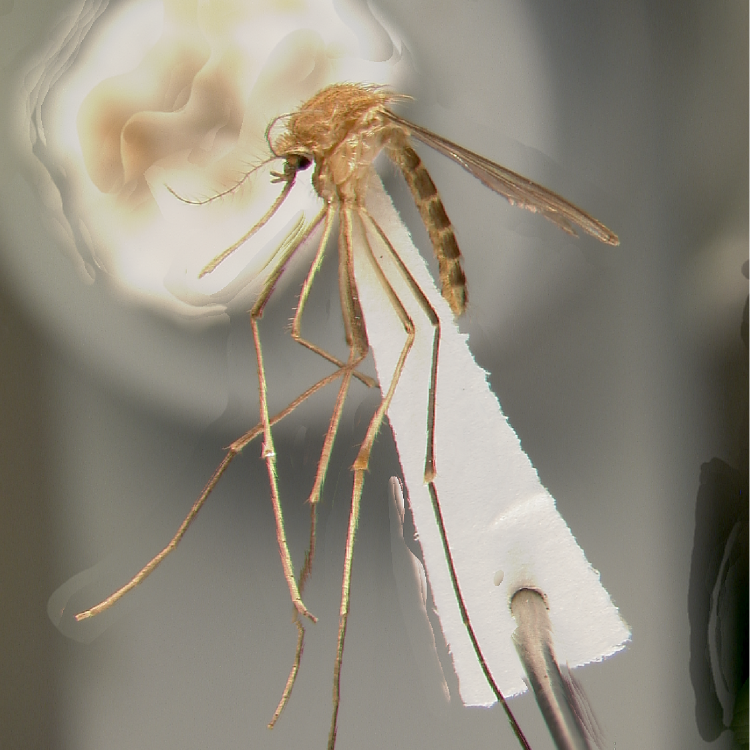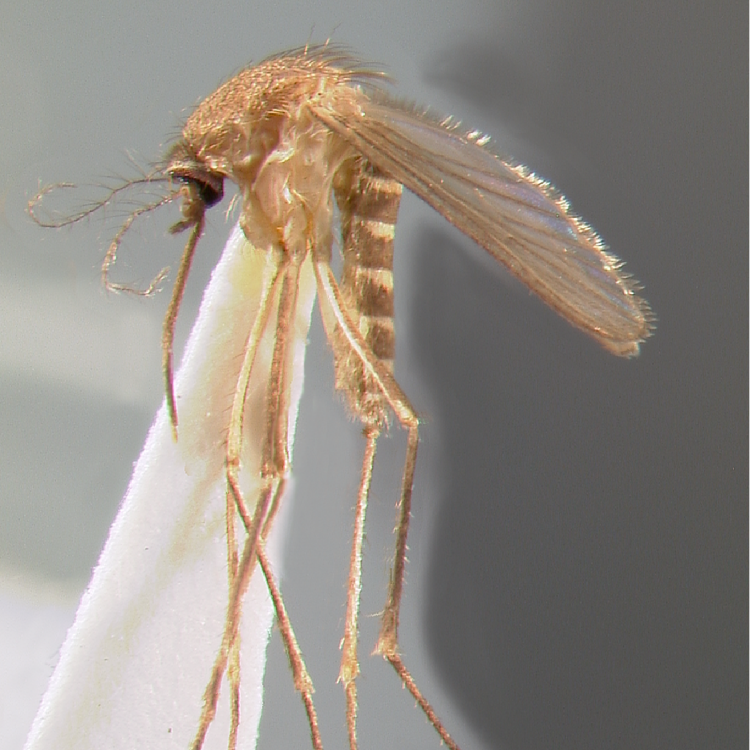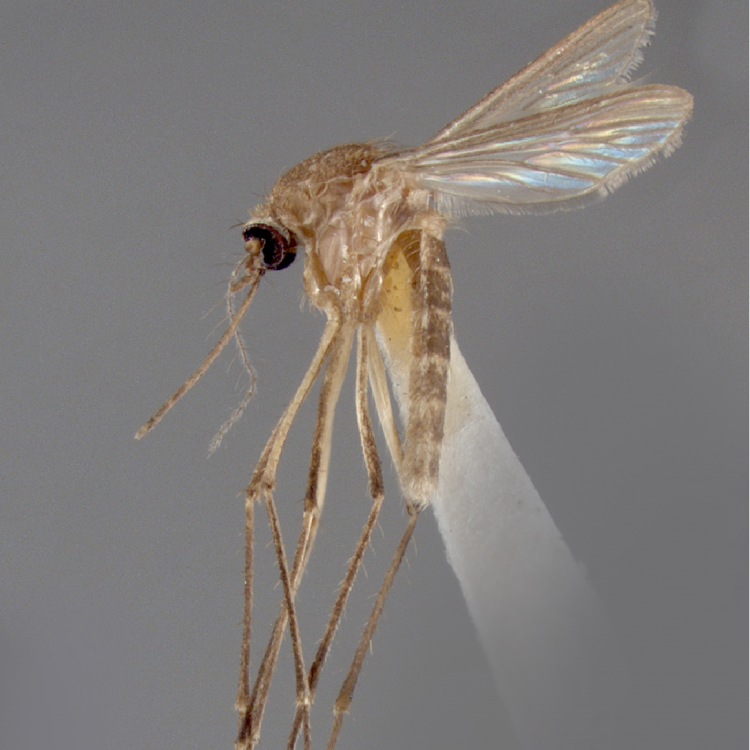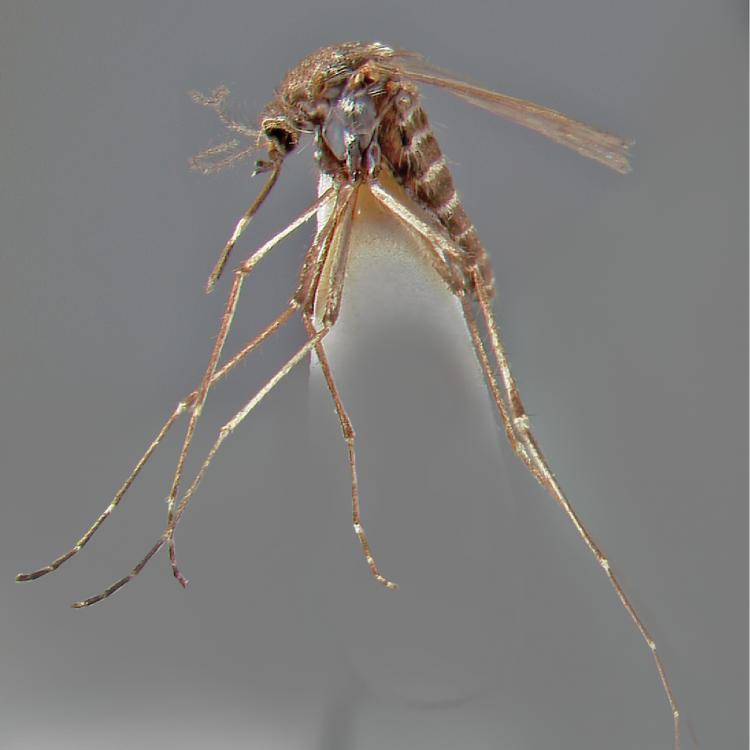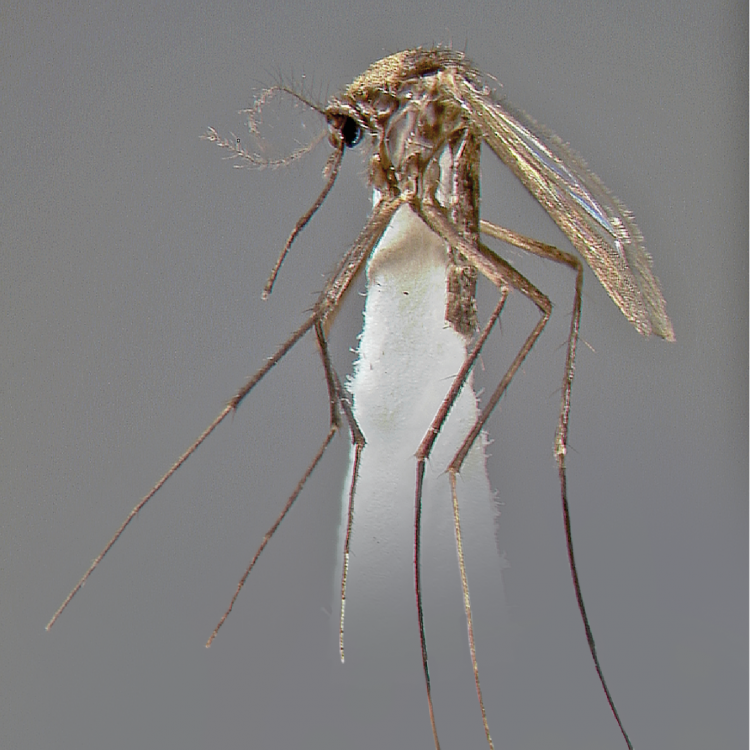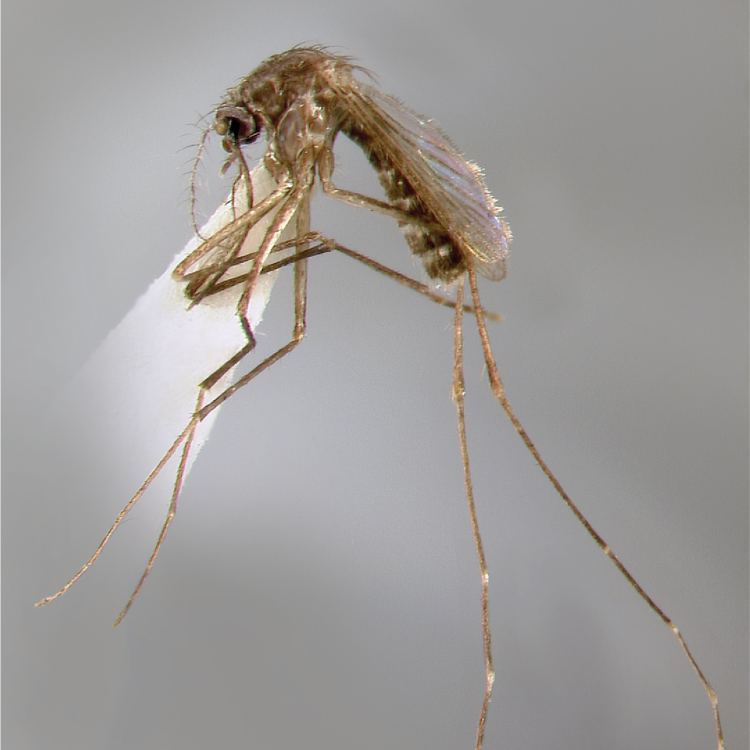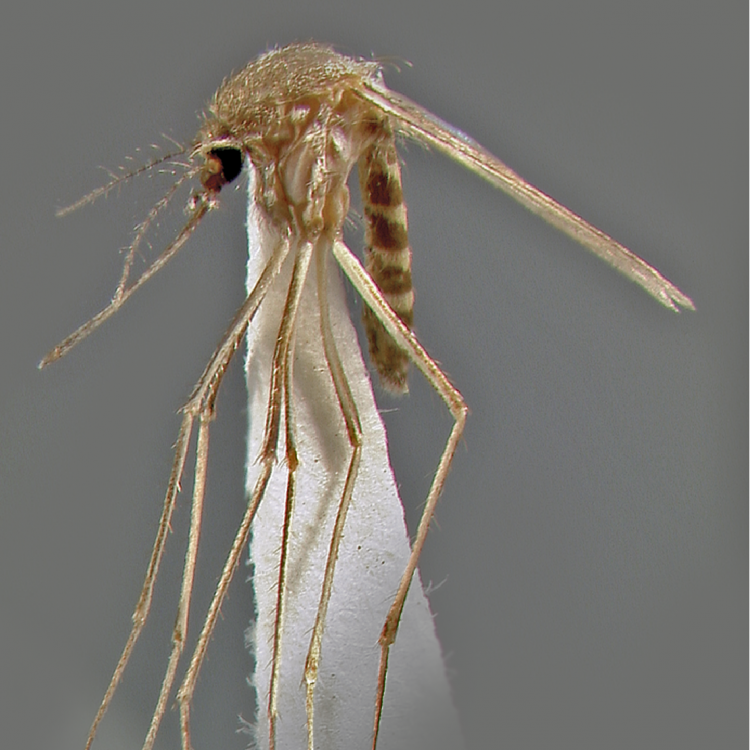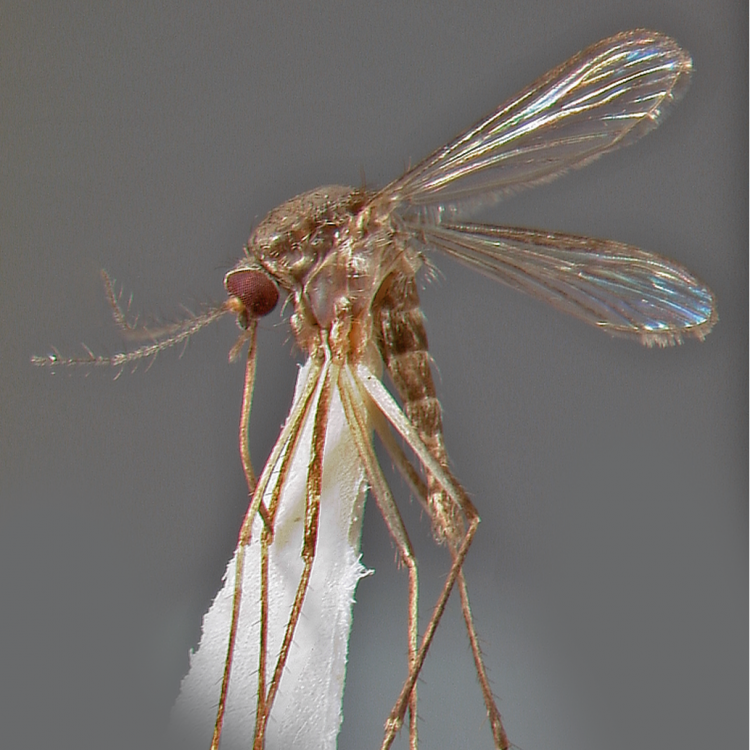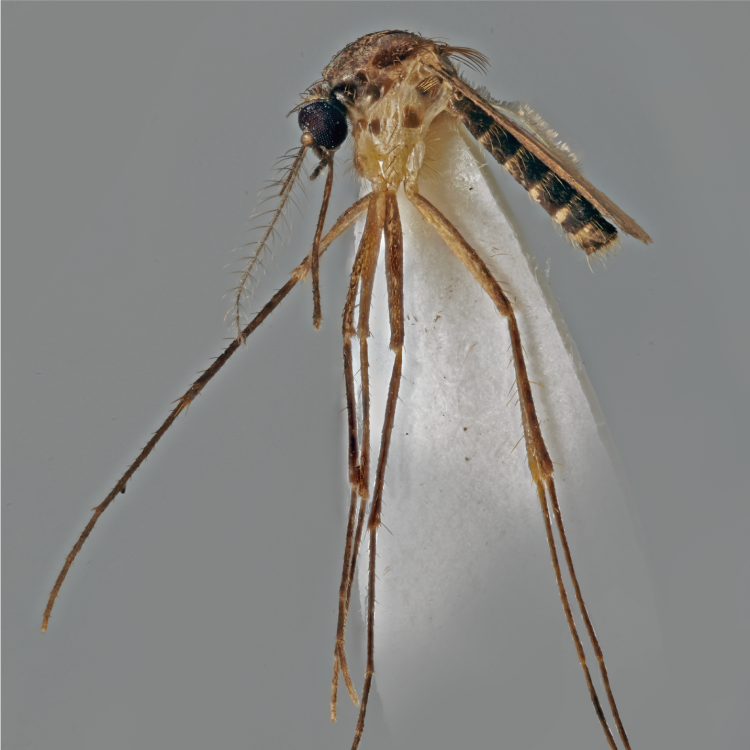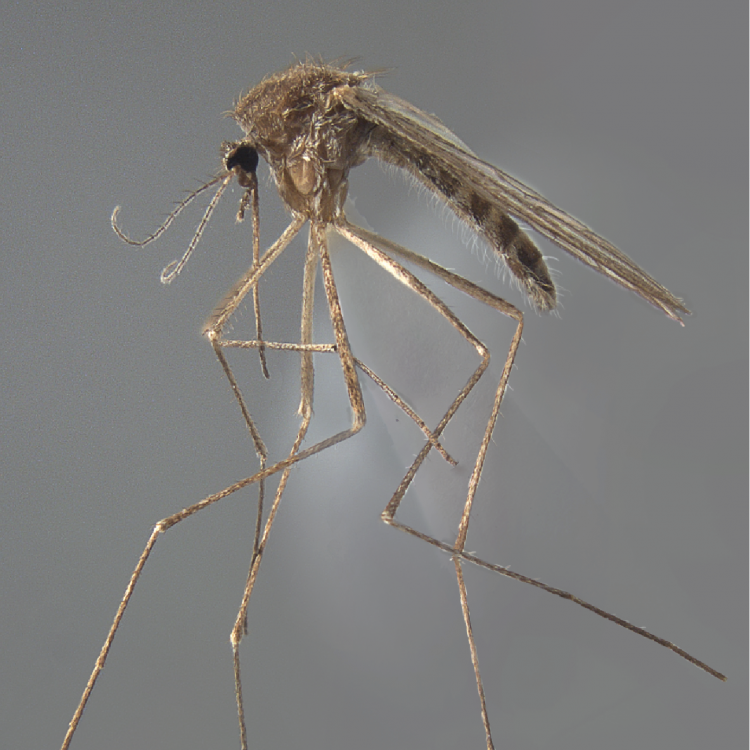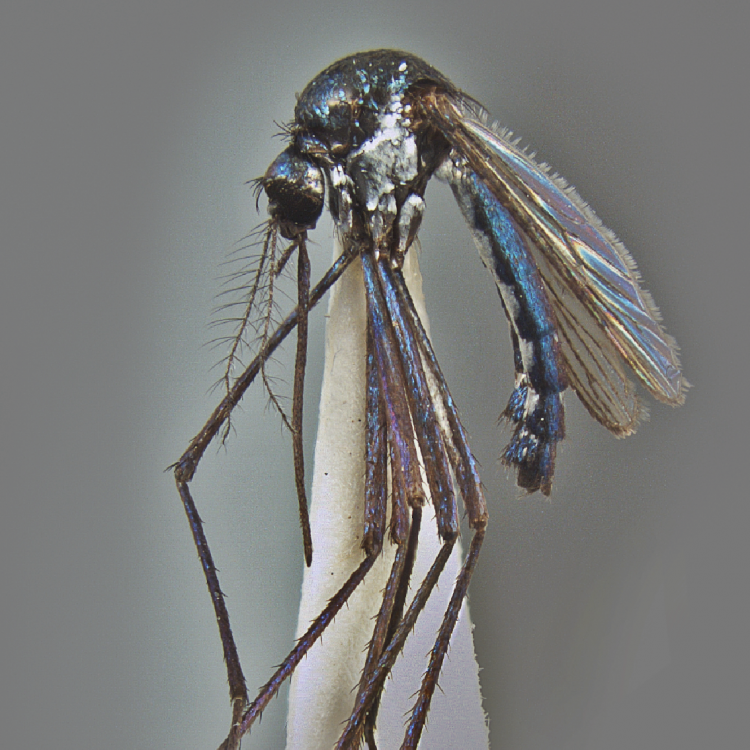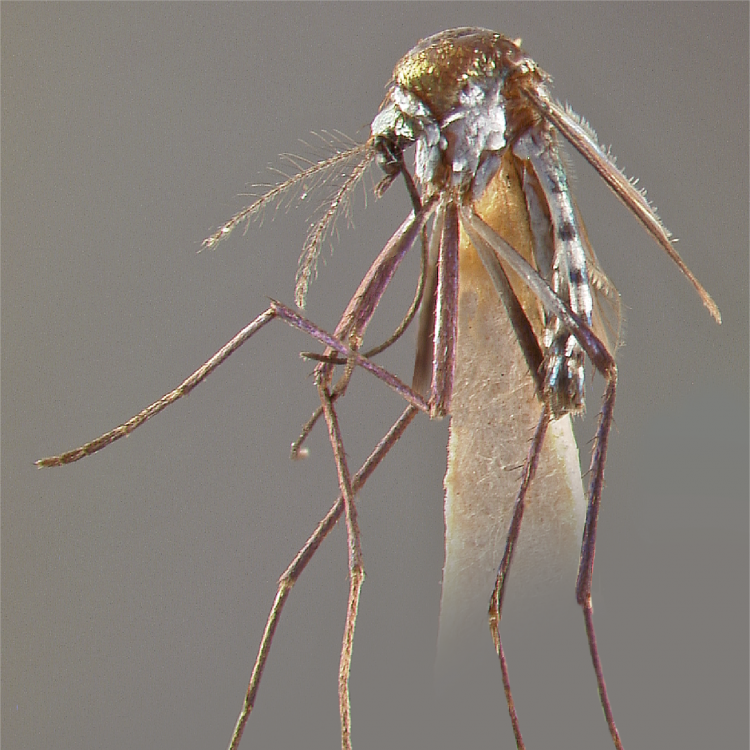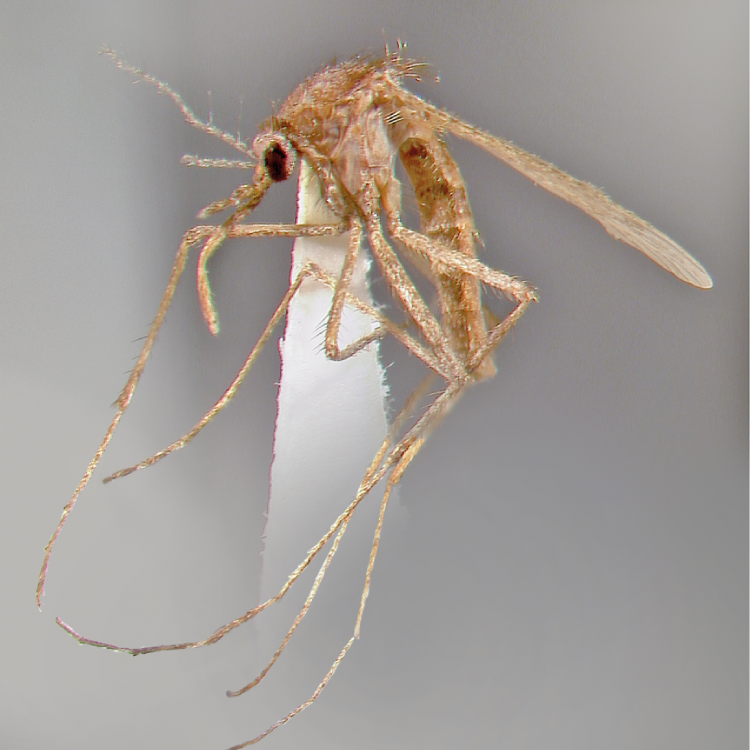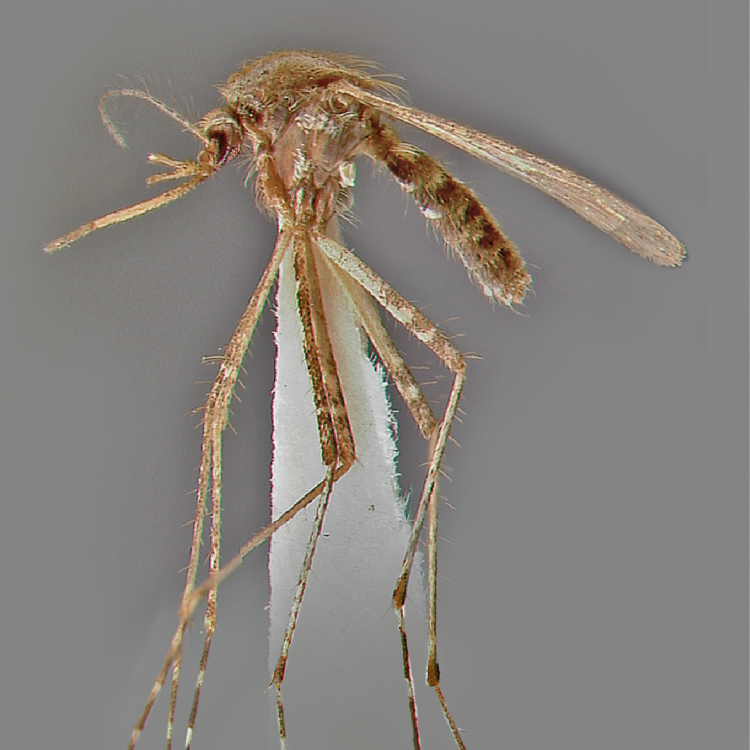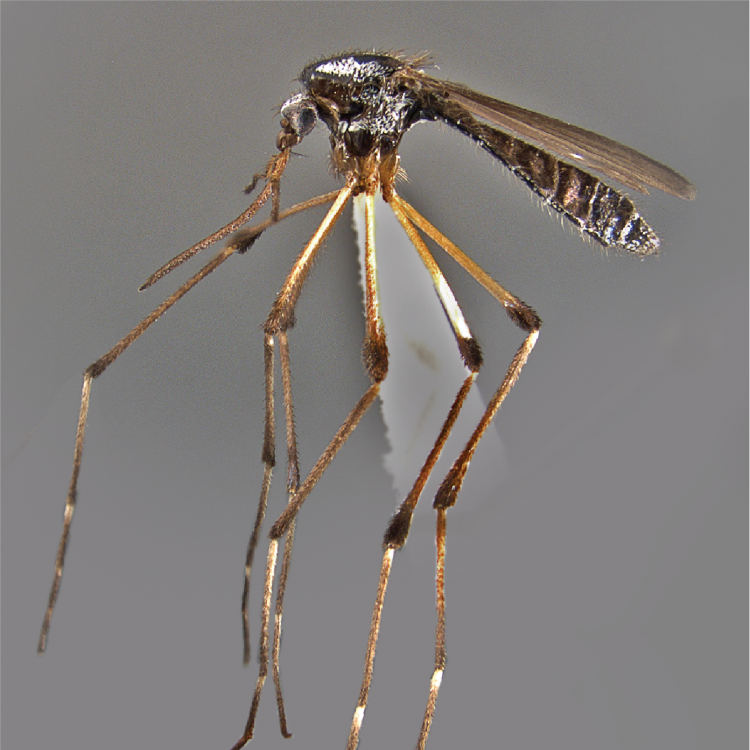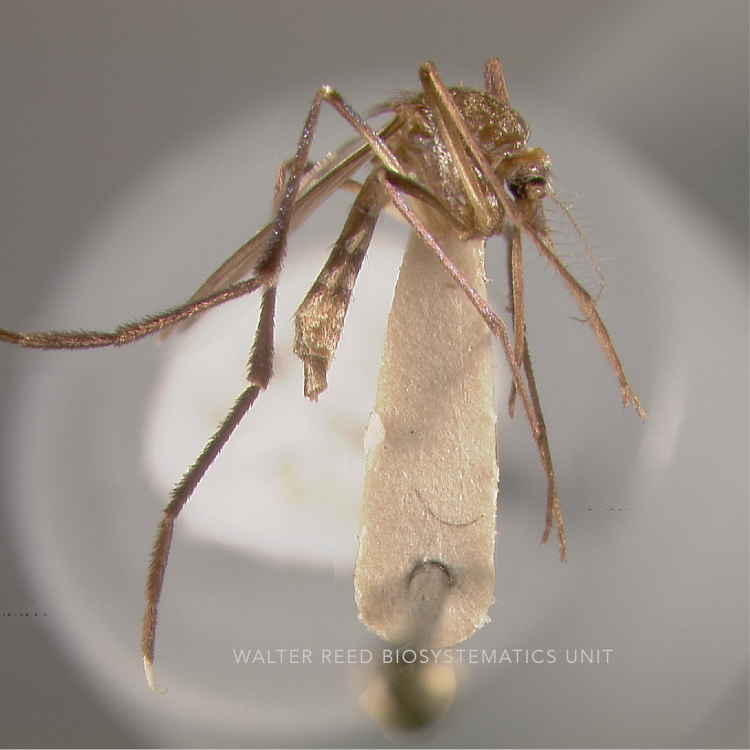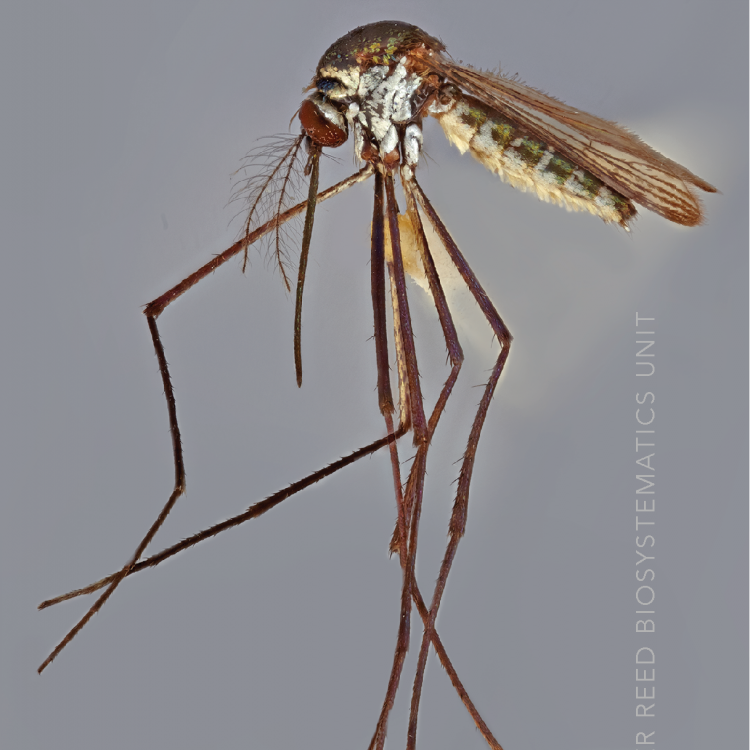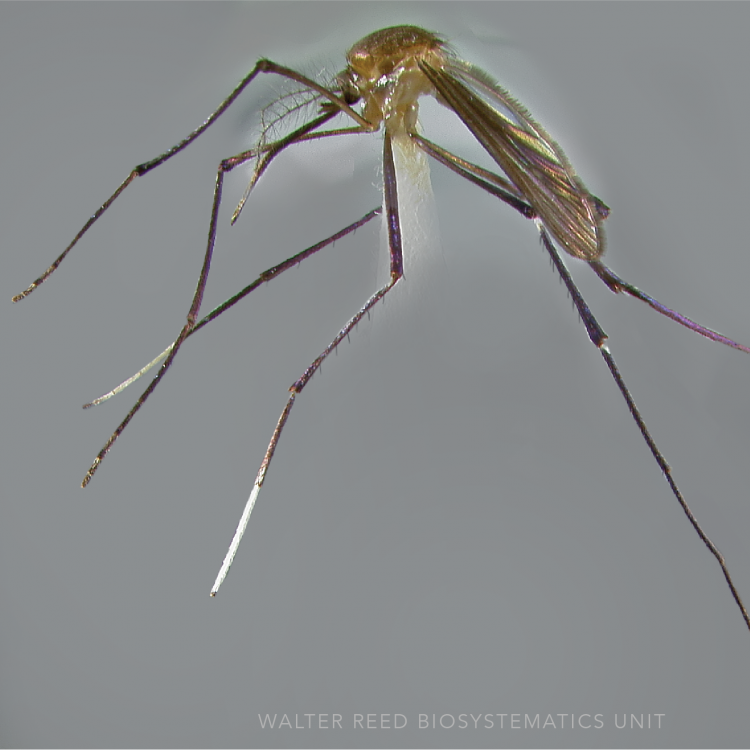PALEARCTIC & ORIENTAL REGIONS
Etymology: not stated [Vishnu (a Hindu deity)]
Culex vishnui is the nominotypical member of the Vishnui Subgroup which comprising eight species, includes three important vectors of Japanese encephalitis virus—Cx. tritaeniorhynchus Giles, Cx. pseudovishnui Colless, and Cx. vishnui Theobald. Other members include: Cx. alienus Colless, Cx. annulus Theobald, Cx. incognitus Baisas, Cx. perplexus Leicester, Cx. philippinensis Sirivanakarn, and Cx. whitei Barraud. As adults, Cx. vishnui is most commonly sympatric with Cx. tritaeniorhynchus, but is separated by possessing a distinct median pale band on the proboscis.
Type locality: Madras, India
Type depository: Natural History Museum, London, England, United Kingdom (NHMUK)
DIAGNOSTIC CHARACTERS (Click photos to view; mouse over and click large photo to zoom in.)
ADULT (illustrated): Head: Proboscis with distinct median band not extending basally onto ventral surface; vertex pale brown-scaled. Thorax: Scutum pale brown-scaled; acrostichal setae present; pleuron with distinct scale patches; postspiracular scales absent; lower mesepimeron setae absent; terga with only basal bands. Wing: Vein R2+3 shorter than vein R2. Legs: Ta-I–III pale-banded; Fe-I,II without anterior speckling; Fe-III with apical dark band.
LARVA (not illustrated): Head: Dorsal apotome distinctly separated from median labral plate (MLP); seta 1-C stout. Thorax: Integument with numerous spicules. Terminal segments: Comb scales fringed with long spinules, apex pointed, spine-like, >10 in 3 or 4 rows; seta 1-S tufts with ≥5 branches; anal papillae > saddle length; siphon long, index >5.0.
TAXONOMIC KEYS
Lee et al. 1989a
Darsie & Pradhan 1990
Tanaka 2004a
Rattanarithikul et al. 2005a
![]()
WRBU – Culex (Cux.) - Australasian Region – Larva
![]()
WRBU – Culex (Cux.) - Indomalayan Region – Adult
![]()
WRBU – Culex (Cux.) - Indomalayan Region – Larva
![]()
WRBU – Culex (Cux.) - Oriental Region – Adult
![]()
WRBU – Culex (Cux.) - Oriental Region – Larva
![]()
WRBU – Culex (Cux.) - Eastern Palearctic Region – Adult
Exemplar DNA sequences
Cx. vishnui COI: KC876678–79, AB738095, AB738149, AB738195–96, AB690844, AY729973, MF179237–40, HM769285–86
BIONOMICS
Immatures
Culex vishnui is closely associated with rice agriculture—its population density explodes in the early part of the rice cultivation cycle, where the there is little shade from the young plants and the shallow waters are warmest. As the rice vegetation grows taller, it is typically replaced by Cx. tritaeniorhynchus Giles. Immature Cx. vishnui have been found in stream and ground pools, drainage ditches, road ruts, and animal footprints.
Adults
Culex vishnui are primarily exophilic and zoophilic. Densities of Cx. vishnui are positively correlated with cattle density—its favored host—in Vietnam. In southern India, blood meals were 64.3% bovine and 35.5% porcine with the remainder comprised of man, goats and birds. Human-feeding increases markedly in the hot season in India, when most people sleep outdoors. Culex vishnui has also been reported entering homes to bite humans, especially when populations are high. Host-seeking females of Cx. vishnui are collected in high densities in light traps and animal-baited traps. Peak biting activity occurs at dusk.
DISTRIBUTION NOTES
Bangladesh, Borneo, Cambodia, India, Indonesia, Japan, Laos, Malaysia, Maldives, Myanmar, Nepal, Papua New Guinea, Pakistan, People's Republic of China (includes Hong Kong), Philippines, Singapore, South Korea, Sri Lanka, Taiwan, Thailand, Timor, Vietnam.
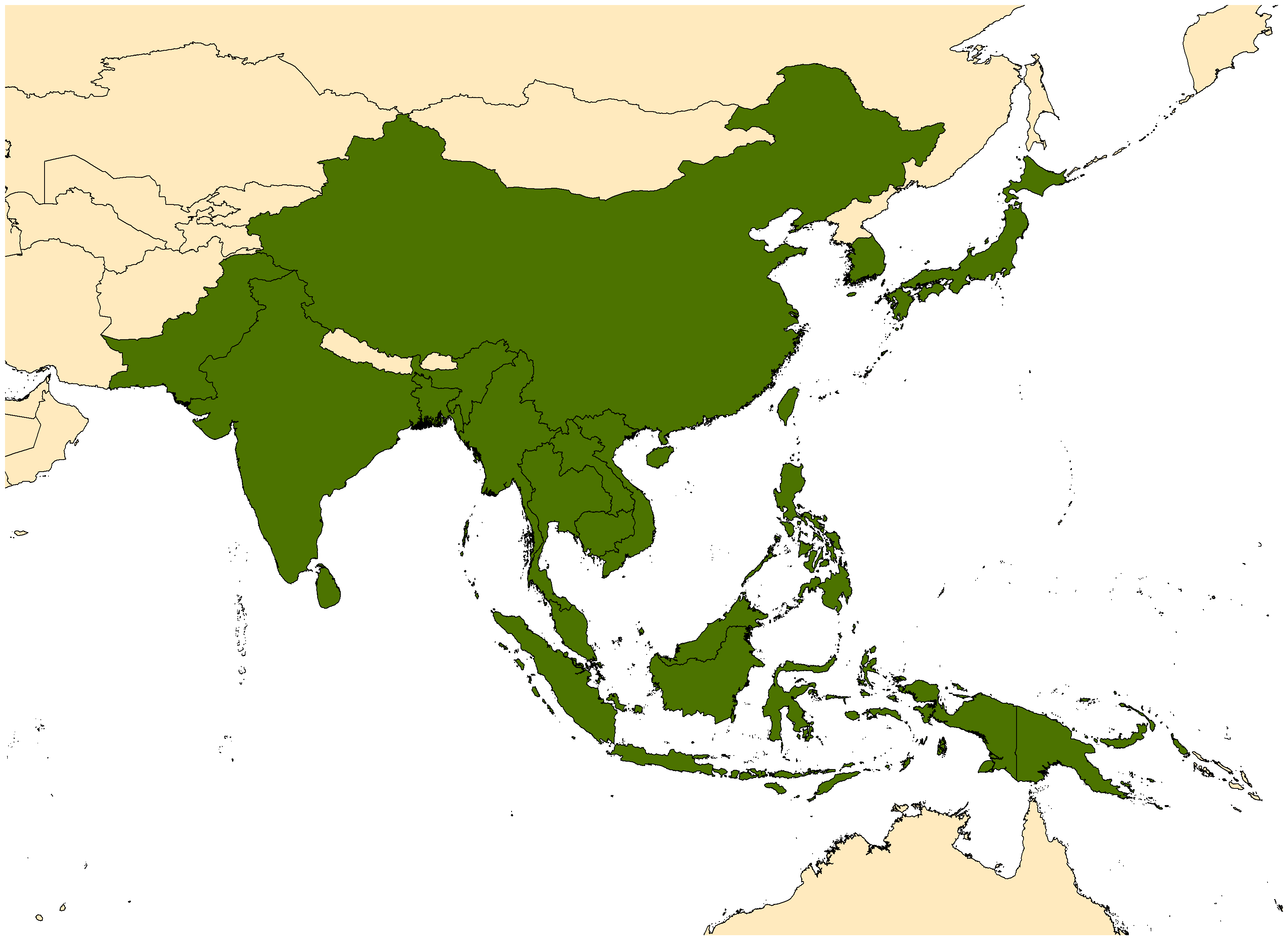
WRBU VECTOR HAZARD REPORTS
None; View other WRBU Vector Hazard Reports
Available GIS Models:
IMPORTANT REFERENCES (full citations below)
Theobald 1901a: 355 (type F*, only)
Barraud 1923c (L*)
Barraud 1934: 400 (M*, F, L*)
Bohart & Ingram 1946b: 83 (M*, F, L*; bionomics, distribution, taxonomy)
LaCasse & Yamaguti 1950: 236 (M*, F*, P*, L*; bionomics, distribution, taxonomy)
Iyengar & Menon 1955 (distribution)
Colless 1957a: 87 (M; taxonomy)
Joshi et al. 1965 (distribution; Nepal)
Reuben 1969: 643 (M*, F*, L*; synonym)
Aslamkhan 1971b (distribution; Pakistan)
Lotfi 1973: 204 (distribution)
Pinhão 1974 (distribution; Timor)
Sirivanakarn 1975: 71 (M*, F*, P*, L*)
Sirivanakarn 1976: 111 (M*, F*, P*, L*; distribution)
Lee et al. 1989a: 269 (F key, taxonomy, bionomics, distribution, review)
Darsie & Pradhan 1990 (F, L; taxonomy, keys, bionomics, distribution; Nepal)
Suleman et al. 1993 (distribution; Pakistan)
Whelan & Hapgood 2000 (bionomics, distribution; East Timor)
Tanaka 2004a: 41 (P; taxonomy, key)
Rattanarithikul et al. 2005a (F*, L*; keys, bionomics, distribution; Thailand)
CURRENT SYNONYMS
None
CITED REFERENCES
Aslamkhan, M. (1971b). The mosquitoes of Pakistan I. A checklist. Mosquito Systematics, 3(4), 147–159.
Barraud, P. J. (1923c). A revision of the culicine mosquitoes of India. Part III. Notes on certain Indian species of the genus Finlaya, Theo. and descriptions of new species. Indian Journal of Medical Research (Calcutta), 11(1), 214–219.
Barraud, P. J. (1934). The fauna of British India, including Ceylon and Burma. Diptera. Vol. 5. Family Culicidae, tribes Megarhinini and Culicini (Vol. 5). London: Taylor and Francis.
Bohart, R.M., & Ingram, R.L. (1946b). Mosquitoes of Okinawa and islands in the Central Pacific. In: United States NAVMED (Bureau of Medicine and Surgery, Navy Department) (pp. 110). Washington.
Colless, D.H. (1957a). Notes on the culicine mosquitoes of Singapore. II.- The Culex vishnui group (Diptera, Culicidae), with descriptions of two new species. Annals of Tropical Medicine and Parasitology, 51(1), 87–101.
Darsie, R.F., Jr., & Pradhan, S.P. (1990). The mosquitoes of Nepal: Their identification, distribution and biology. Mosquito Systematics, 22(2), 69–130.
Iyengar, M.O.T, & Menon, M.A.U. (1955). Mosquitos of the Maldive Islands. Bulletin of Entomological Research, 46, 1–10.
Joshi, G., Pradhan, S., & Darsie, Jr., R.F. (1965). Culicine, Sabethine and Toxorhynchitine mosquitoes of Nepal including new country records (Diptera: Culicidae). Proceedings of the Entomological Society of Washington, 67(3), 137–146.
LaCasse, W.J., & Yamaguti, S. (1950). Mosquito fauna of Japan and Korea. Office of the Surgeon General, Headquarters, 8th Army, APO 343. United States. 207th Malaria Survey Detachment.
Lee, D.J., Hicks, M.M., Debenham, M.L., Griffiths, M., Marks, E.N., Bryan, J.H., & Russell, R.C. (1989a). The Culicidae of the Australasian region. Volume 7. Commonwealth Department of Health, School of Public Health and Tropical Medicine Monograph Series, 2.
Lotfi, M.D. (1973). Iranian species of genus Culex (Culicinae: Diptera). II. Report of four species of larvae (including three new records) and 14 adult species. Bulletin de la Société de pathologie exotique (Paris), 66, 204–207.
Pinhão, Rui da Costa (1974). Sôbre a situação zoogeográfica de Timor. Anais do Instituto de Hygiene e Medicina Tropical, 1(1–4), 467–470.
Rattanarithikul, R., Harbach, R.E., Harrison, B.A., Panthusiri, P., Jones, J.W., & Coleman, R.E. (2005). Illustrated keys to the mosquitoes of Thailand. II. Genera Culex and Lutzia. Southeast Asian Journal of Tropical Medicine and Public Health, 36 (Supplement 2), 1–97.
Rattanarithikul, R., Harrison, B.A., Panthusiri, P., & Coleman, R.E. (2005a). Illustrated keys to the mosquitoes of Thailand. I. Background; geographic distribution; lists of genera, subgenera, and species; and a key to the genera. Southeast Asian Journal of Tropical Medicine and Public Health, 36(1), 1–80.
Reuben, R. (1969). A redescription of Culex vishnui Theo., with notes on C. pseudovishnui Colless and C. tritaeniorhynchus Giles, from southern India. Bulletin of Entomological Research, 58(3), 643–652.
Sirivanakarn, S. (1976). Medical entomology studies - III. A revision of the subgenus Culex in the Oriental region (Diptera: Culicidae). Contributions of the American Entomological Institute, 12(2), 1–272.
Suleman, M., Khan, K., & Khan, S. (1993). Ecology of mosquitoes in Peshawar Valley and adjoining areas: Species composition and relative abundance. Pakistan Journal of Zoology, 25(4), 321–328.
Tanaka, K. (2004a). Studies on the pupal mosquitoes of Japan. (10) Culex (Culex) (Diptera, Culicidae). Japanese Journal of Systematic Entomology, 10(1), 9–42.
Theobald, F.V. (1901a). A monograph of the Culicidae or mosquitoes (Vol. 1). London: British Museum (Natural History). [424pp]
Whelan, P., & Hapgood, G. (2000). A mosquito survey of Dili, East Timor, and implications for disease control. Arbovirus Research in Australia, 8, 405–416.
CITE THIS PAGE
Walter Reed Biosystematics Unit (Year). Culex vishnui species page. Walter Reed Biosystematics Unit Website, http://wrbu.si.edu/vectorspecies/mosquitoes/vishnui, accessed on [date (e.g. 03 February 2020) when you last viewed the site].


